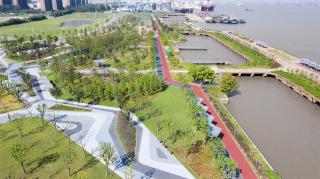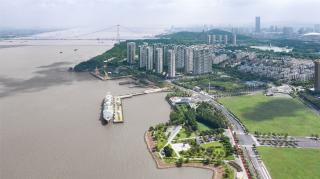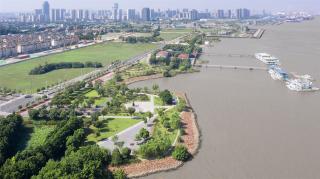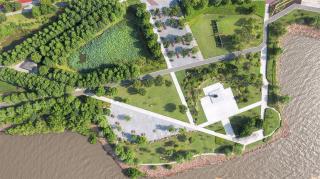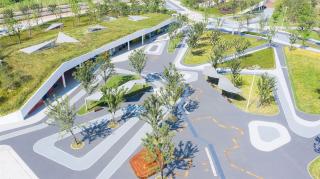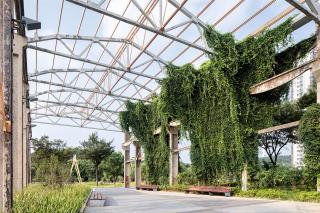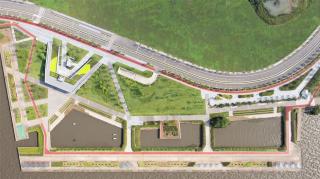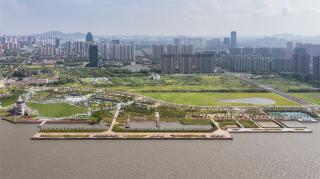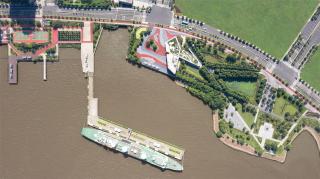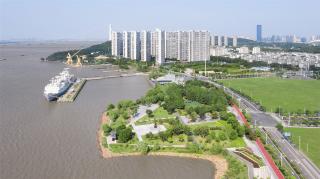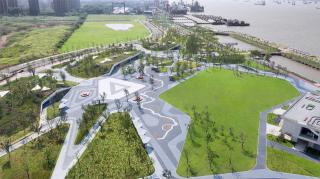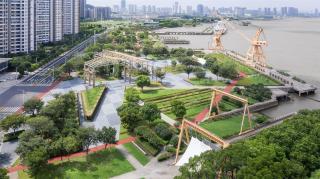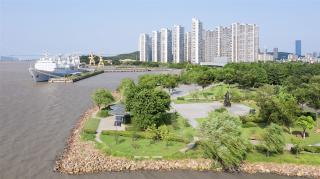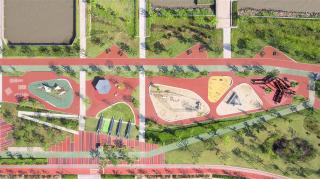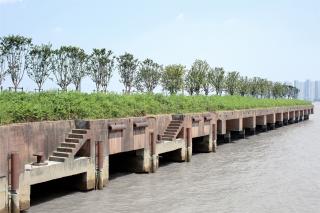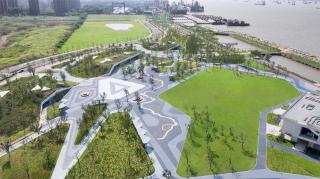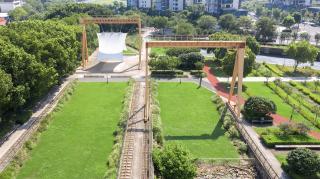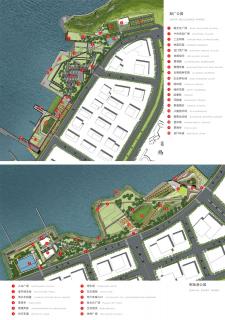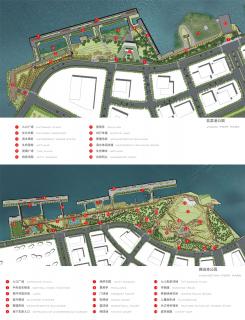
▲設(shè)計(jì)保留了場地歷史痕跡���,重新建立了生態(tài)廊道 This design maintained traces of the site's history and re-established indigenous eco-system corridors ? 夏至
江陰坐落于水運(yùn)繁忙的“黃金水道”長江之畔�,目前正致力于將其部分工業(yè)碼頭改造為高密度的生活-工作區(qū)。這一改造項(xiàng)目的第一階段正是沿著江邊再造一個(gè)長達(dá)4公里的公共區(qū)域���。該項(xiàng)目業(yè)主通過邀請(qǐng)競賽抉擇最佳設(shè)計(jì)�,BAU的方案脫穎而出。
Jiangyin is on the Yangtze, the world’s busiest working river. The city is regenerating part of its industrial docklands as a high density live-work district. Stage one of this major project is the creation of a 4km public realm along the river edge. The design was selected through invited competition.
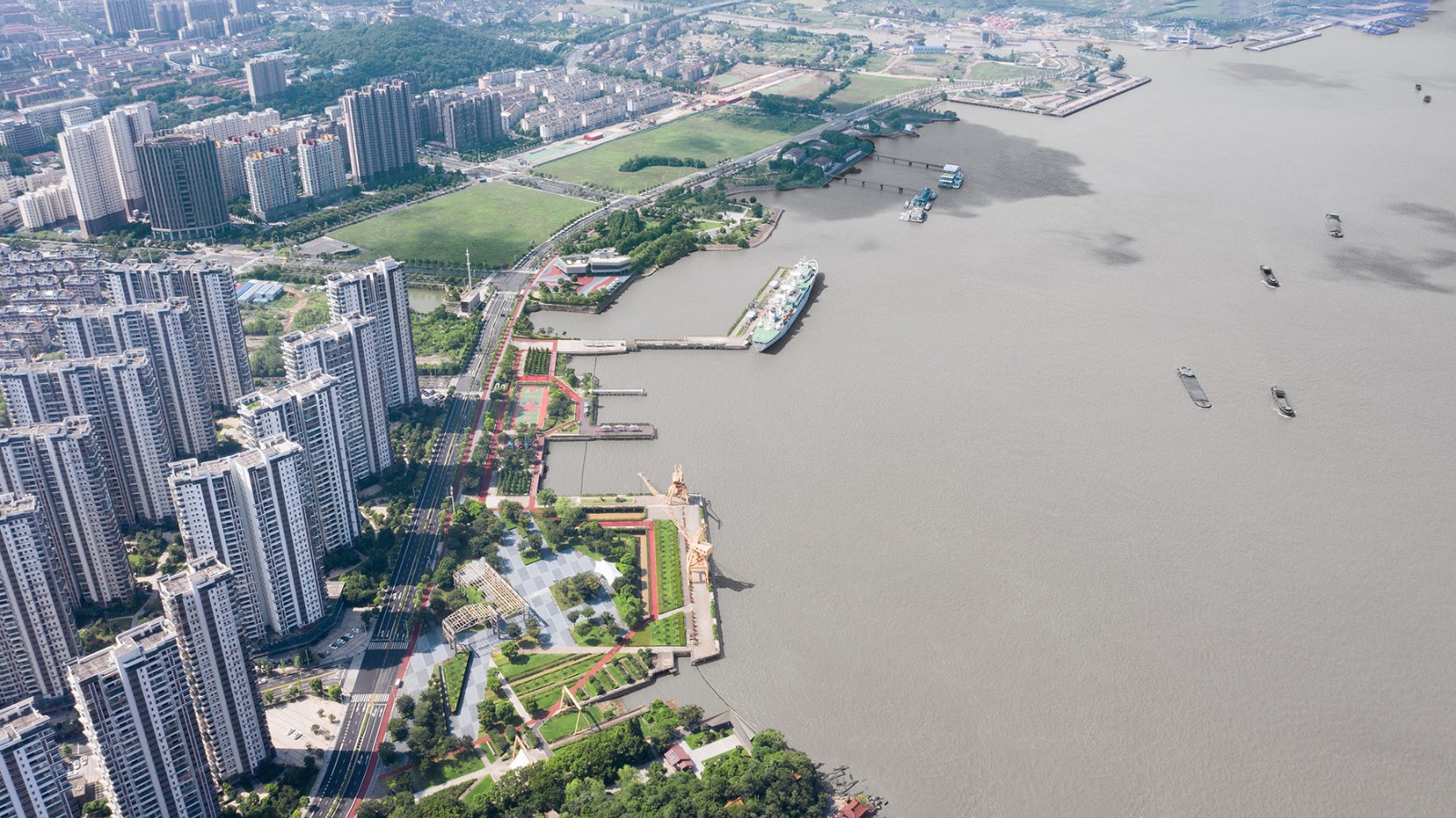
▲項(xiàng)目的第一階段是沿著江邊再造一個(gè)長達(dá)4公里的公共區(qū)域 Stage one of this major project is the creation of a 4km public realm along the river edge ? 夏至
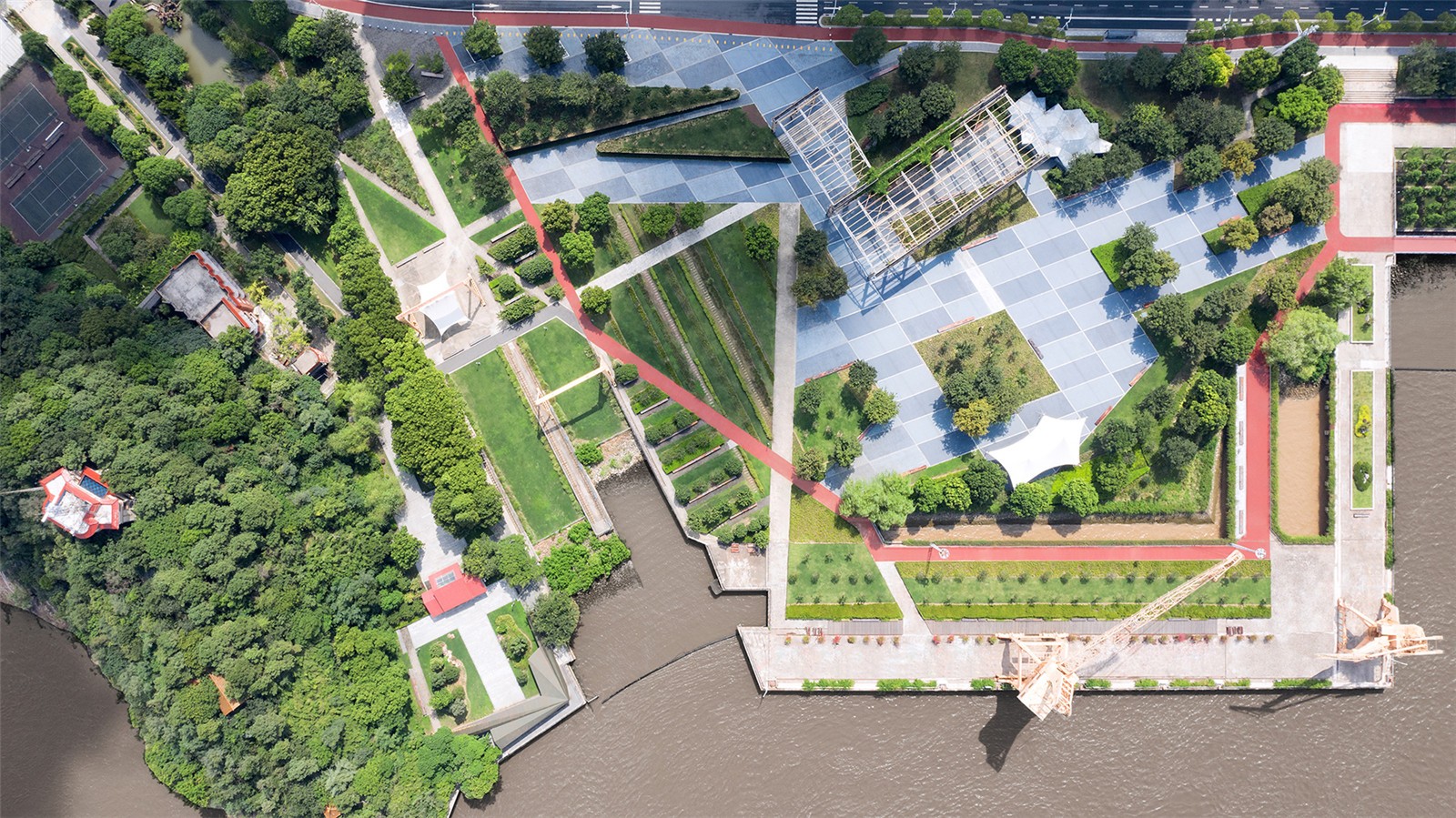
▲步道���、自行車道��、水上木板路��、場地內(nèi)外視野的延伸以及新區(qū)域的路徑等都使城市與水系的聯(lián)系更加緊密 pedestrian paths, bike paths, water boardwalk, extensions of views to and from the site–all maximizing links between the city and the water ? 夏至
1. 柔和邊界與生態(tài)長廊
Soft edges and eco corridors
不斷漲落的長江潮水滋養(yǎng)了江陰濱江區(qū)域豐富的生態(tài)文化��。濱江公園的建成對(duì)該地區(qū)的微生境而言���,不僅是一種修復(fù)與還原,還是進(jìn)一步的提升與擴(kuò)充�����。江河邊緣的復(fù)雜性通過巖石固定得以加強(qiáng)與穩(wěn)固。一條由當(dāng)?shù)鼐G植貫穿的長廊連接了整個(gè)項(xiàng)目�����,將東邊的鵝鼻嘴山與西邊的生態(tài)長廊串聯(lián)一體�����。
The Yangtze at this location is tidal. This project rehabilitates, preserves, enhances and extends a raft of microhabitats. Complexity of the existing river edge is formally maintained, enhanced and secured with loose rock scaled for habitat. A new corridor of indigenous trees and plants weaves through the project’s length to connect the Ebizui mountain ecological node to the east with the canal eco corridor towards the west.
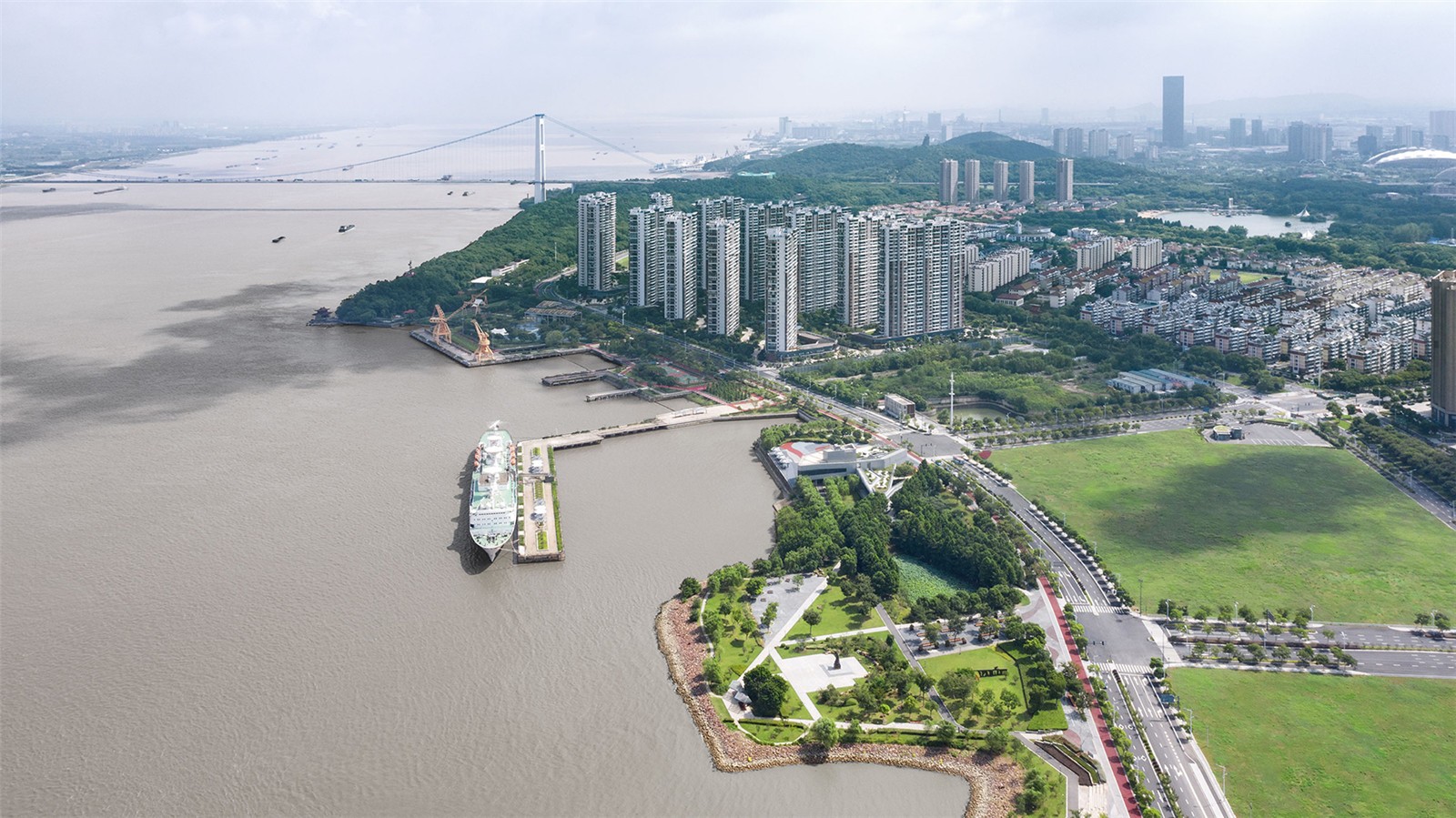
▲一條由當(dāng)?shù)鼐G植貫穿的長廊連接了整個(gè)項(xiàng)目 A new corridor of indigenous trees and plants weaves through ? 夏至
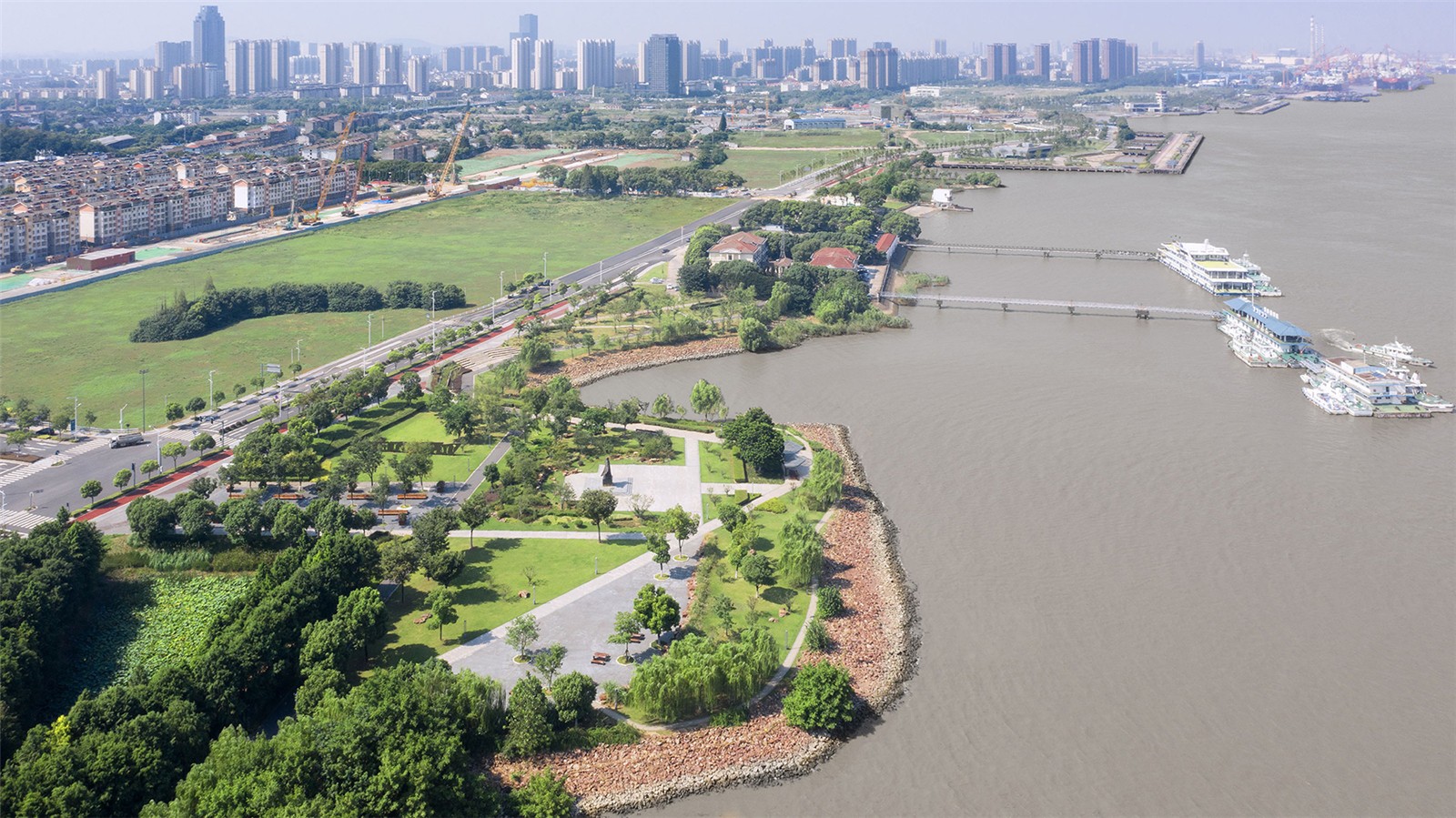
▲江河邊緣的復(fù)雜性通過巖石固定得以加強(qiáng)與穩(wěn)固 Complexity of the existing river edge is formally maintained, enhanced and secured with loose rock scaled for habitat ? 夏至
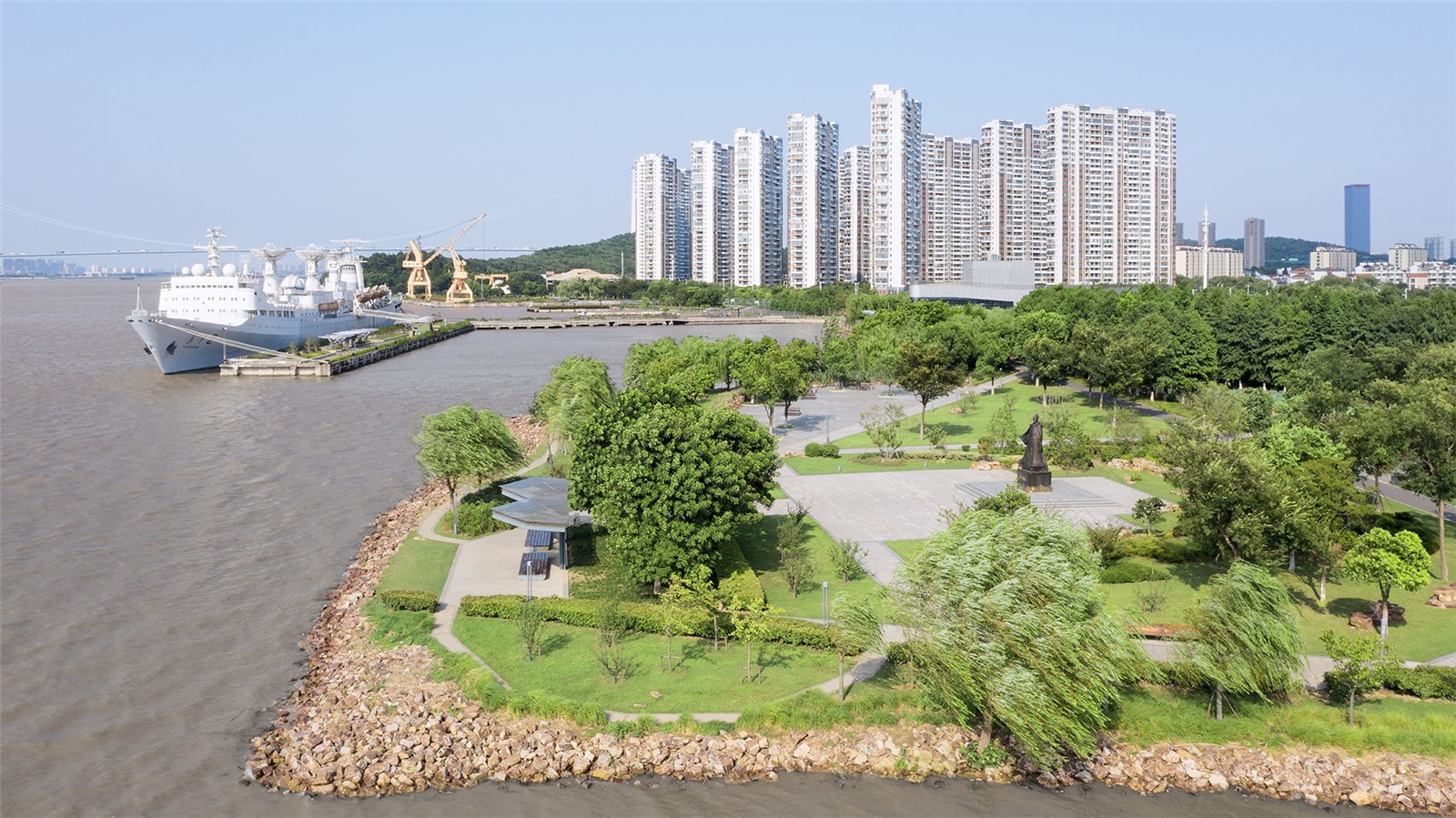
▲項(xiàng)目修復(fù)��、還原并提升擴(kuò)充了該地區(qū)的微生境 This project rehabilitates, preserves, enhances and extends a raft of microhabitats ? 夏至
2. 后工業(yè)時(shí)代的詩意
Post-industrial poetics
在長江日夜不息的沖刷中�,經(jīng)久磨損的廣闊碼頭已被染成棕色。立于碼頭�����,遠(yuǎn)眺無邊江面���,迎面而來的是宏偉江流與磅礴莊嚴(yán)之勢�����。作為揚(yáng)子江造船廠的原址��,濱江公園承載了江陰船舶制造工業(yè)的歷史��,因此我們?cè)谠O(shè)計(jì)中保留了其最原始而野蠻的框架結(jié)構(gòu)�����。圍繞碼頭進(jìn)行的干預(yù)措施使原有工業(yè)環(huán)境的巨型規(guī)模�����、健壯性和清晰度得以保留�����。當(dāng)未來這片區(qū)域遍布植被與豐富的景觀時(shí)�,充滿活力的工業(yè)碼頭必將為居民提供一片逃離世俗繁雜的休憩地���。
The vast worn concrete wharves are colored by the brown earth washed down the Yangtze. Overlooking the two-kilometer river from the prosaic empty docks presents an overwhelming scale and sense of the sublime. This design preserves even the most brutal of structures. Necessary new interventions on and around the wharves share the scale, robustness and clarity of this industrial context. Whilst the future district promises to be filled with vibrancy, and much of the landscape is rich in complexity, the wharf edges provide a rare escape.
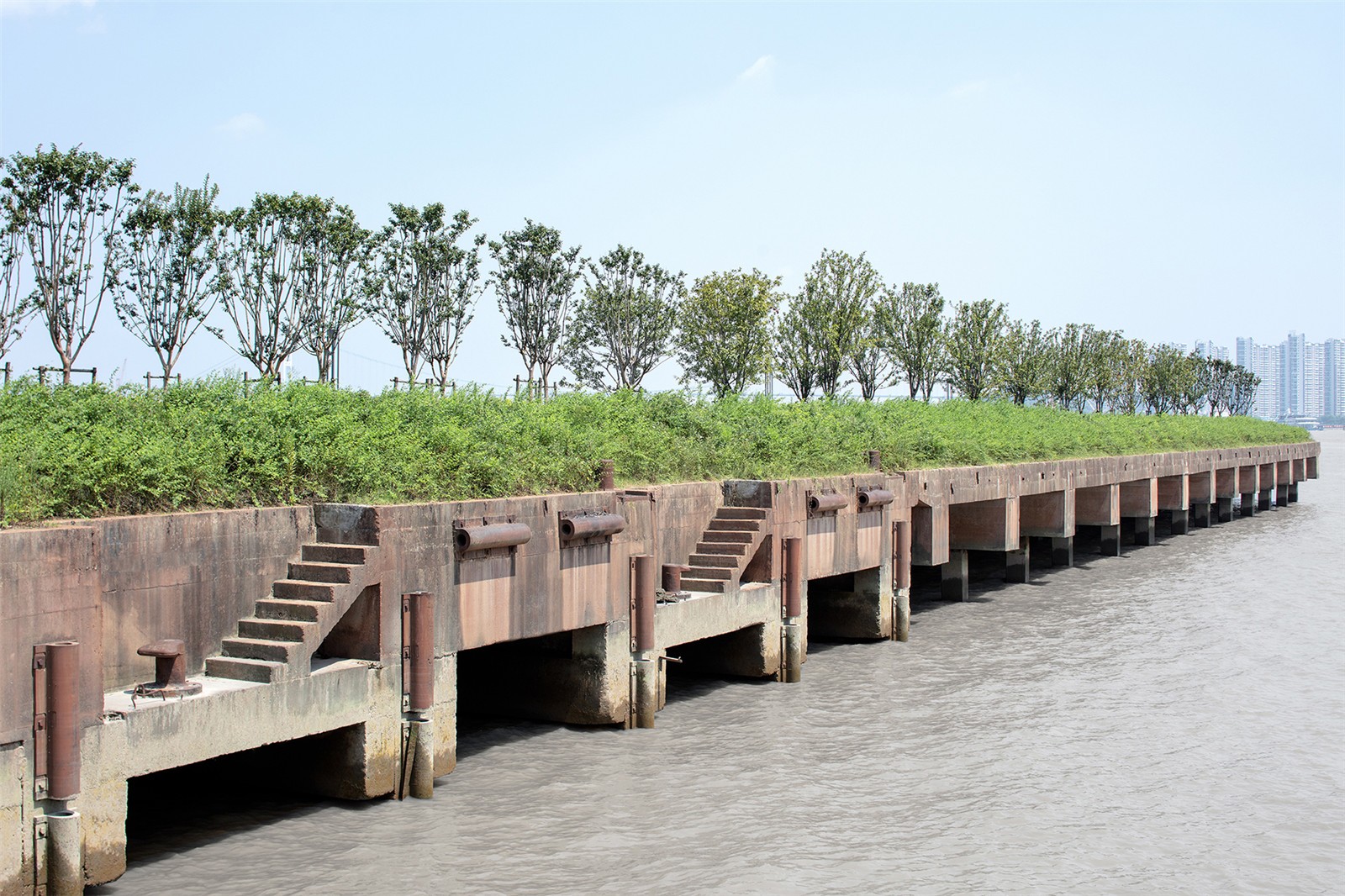
▲被染成棕色的碼頭 The vast worn concrete wharves are colored by the brown earth washed down the Yangtze ? 夏至
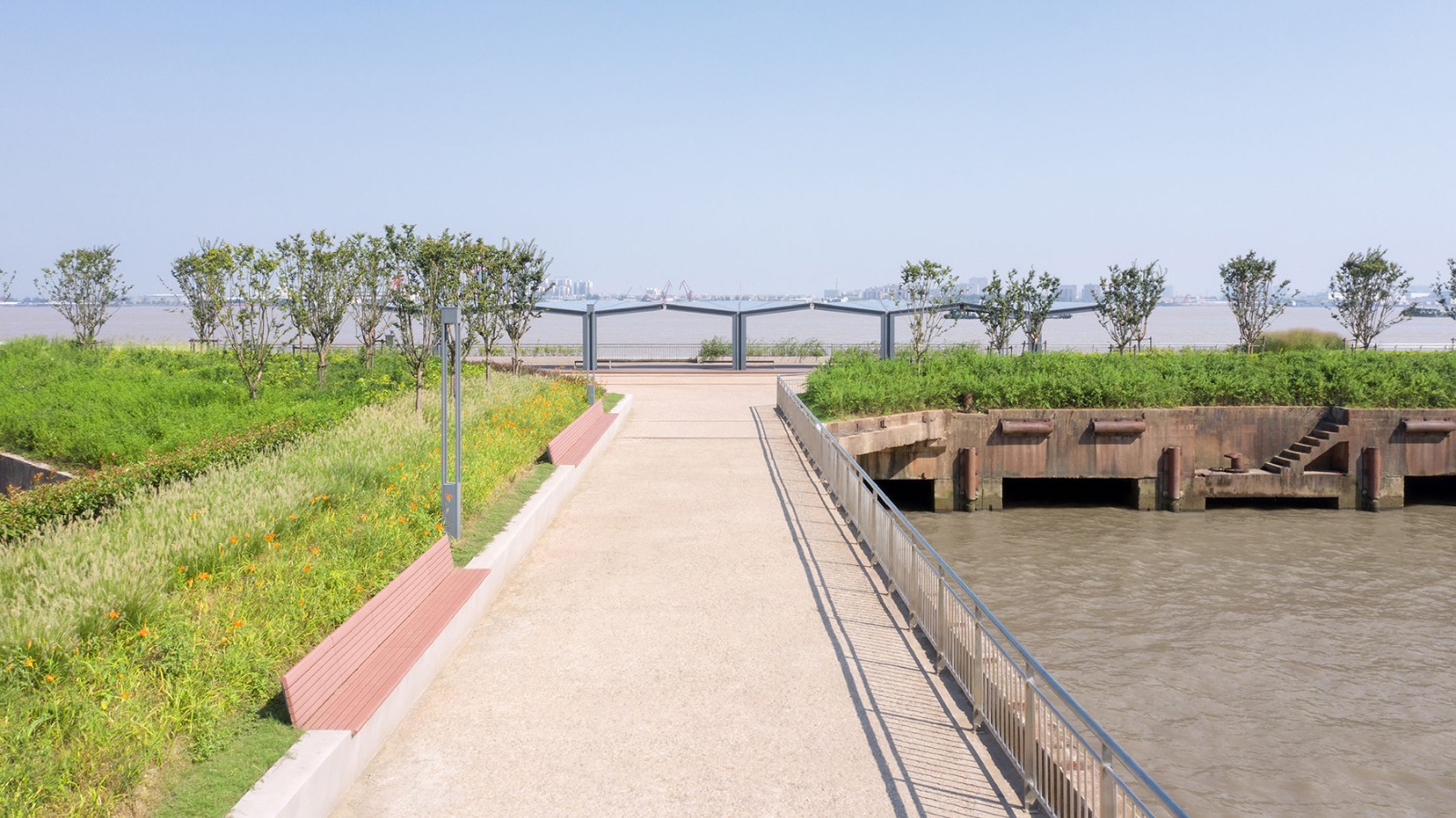
▲圍繞碼頭進(jìn)行的干預(yù)措施使原有工業(yè)環(huán)境的巨型規(guī)模��、健壯性和清晰度得以保留 Necessary new interventions on and around the wharves share the scale, robustness and clarity of this industrial context ? 夏至
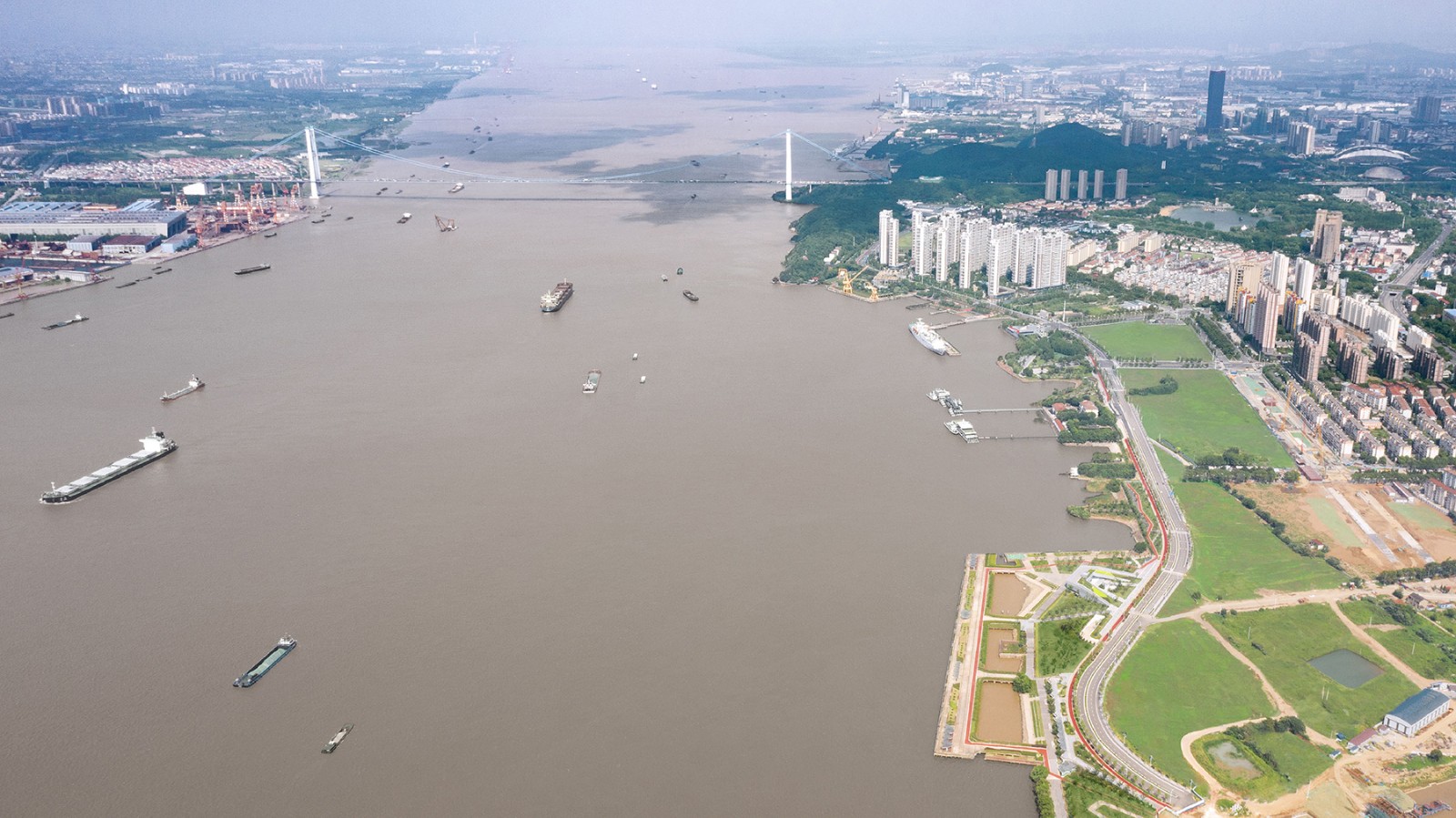
▲場地遠(yuǎn)眺 Overlooking the two-kilometer river from the prosaic empty docks ? 夏至
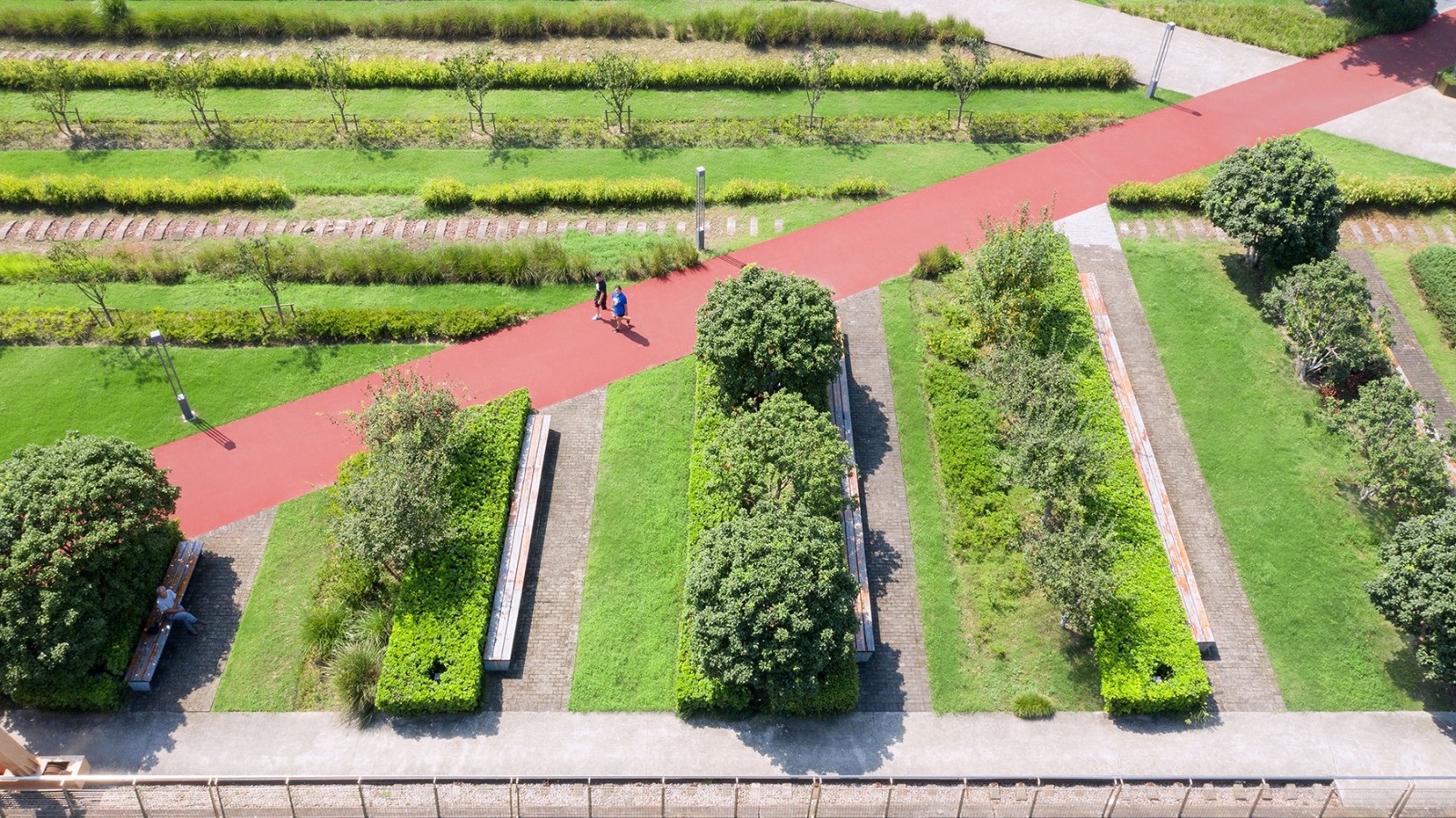
▲為居民提供一片逃離世俗繁雜的休憩地 Much of the landscape is rich in complexity, the wharf edges provide a rare escape ? 夏至
3.歷史的延續(xù)
Continuity with the Past
重寫——船廠公園
Palimpsest – Ship Building Park
發(fā)達(dá)的水運(yùn)和便于儲(chǔ)存貨物的開闊平坦地勢使這片江邊碼頭成為天然港口區(qū)�����,不過在改革開放后���,碼頭東面曾建造為設(shè)施齊全的船廠�����。如今的設(shè)計(jì)不僅保留了該區(qū)域的歷史痕跡�����,還從生態(tài)���、流線及規(guī)劃等層面對(duì)其進(jìn)行了提升。最終呈現(xiàn)的結(jié)果便是一份當(dāng)?shù)貧v史與環(huán)境的復(fù)雜重寫本��,容納各式公共空間并支持兼收并蓄����、多種多樣的戶外活動(dòng)。
Whilst the majority of the site was open and flat for stockpiling raw materials, the eastern portion of the site was recently a functioning ship building facility. The design strategy maintained traces of the site's history and overlaid a number of ecological, circulation and programmatic layers. The result is a complex palimpsest supporting inclusive and diverse open spaces and activities.
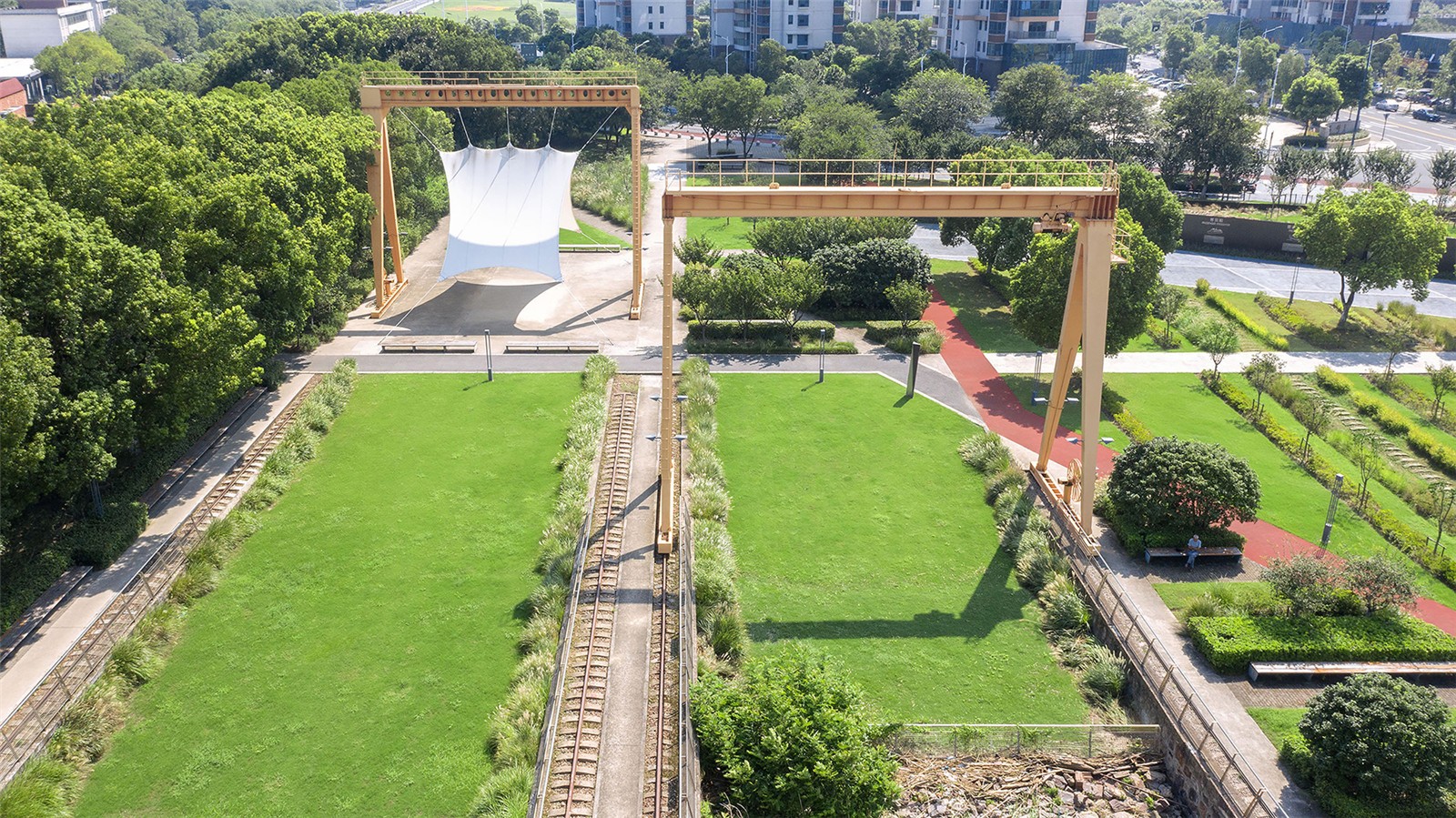
▲歷史痕跡:起重機(jī)與軌道 The history layer: gantry cranes and rails ? 夏至

▲歷史痕跡:防浪堤 The history layer:jetties ? 夏至
區(qū)域內(nèi)留存的歷史痕跡包括:船舶的下水滑道����、龍門起重機(jī)及其軌道、船廠建筑�、防浪堤、中式園林��、被樹包圍的小道及其他眾多文物��。其他層面則包括:聯(lián)結(jié)(步道、自行車道����、水上木板路、場地內(nèi)外視野的延伸以及新區(qū)域的路徑等都使城市與水系的聯(lián)系更加緊密)�����;休閑(運(yùn)動(dòng)場及滑板公園)�;娛樂(船型的兒童探險(xiǎn)游樂場和老年鍛煉區(qū))�����;社交(開闊廣場��、游客中心與大型展覽館)���;休憩(小亭子��、座椅����、野餐桌和船型解說臺(tái))��;生態(tài)(雨水花園、水邊棲息地及生態(tài)長廊)����。
The history layer includes ship slipways; gantry cranes and rails; ship building factory structures; jetties; a Chinese garden; a tree lined road; and numerous other artefacts. Other layers across the site include: connections (pedestrian paths, bike paths, water boardwalk, extensions of views to and from the site, and paths from the new districts – all maximizing links between the city and the water); active leisure (sports courts and skate park); play (children’s adventure playground in the form of a ship, and elderly exercise area); social gathering (large plaza, visitor center, and large pavilions); relaxation (small pavilions, intimate seating, picnic tables, and ship interpretation installation); and ecological (rain gardens, water edge habitats, eco-corridor).
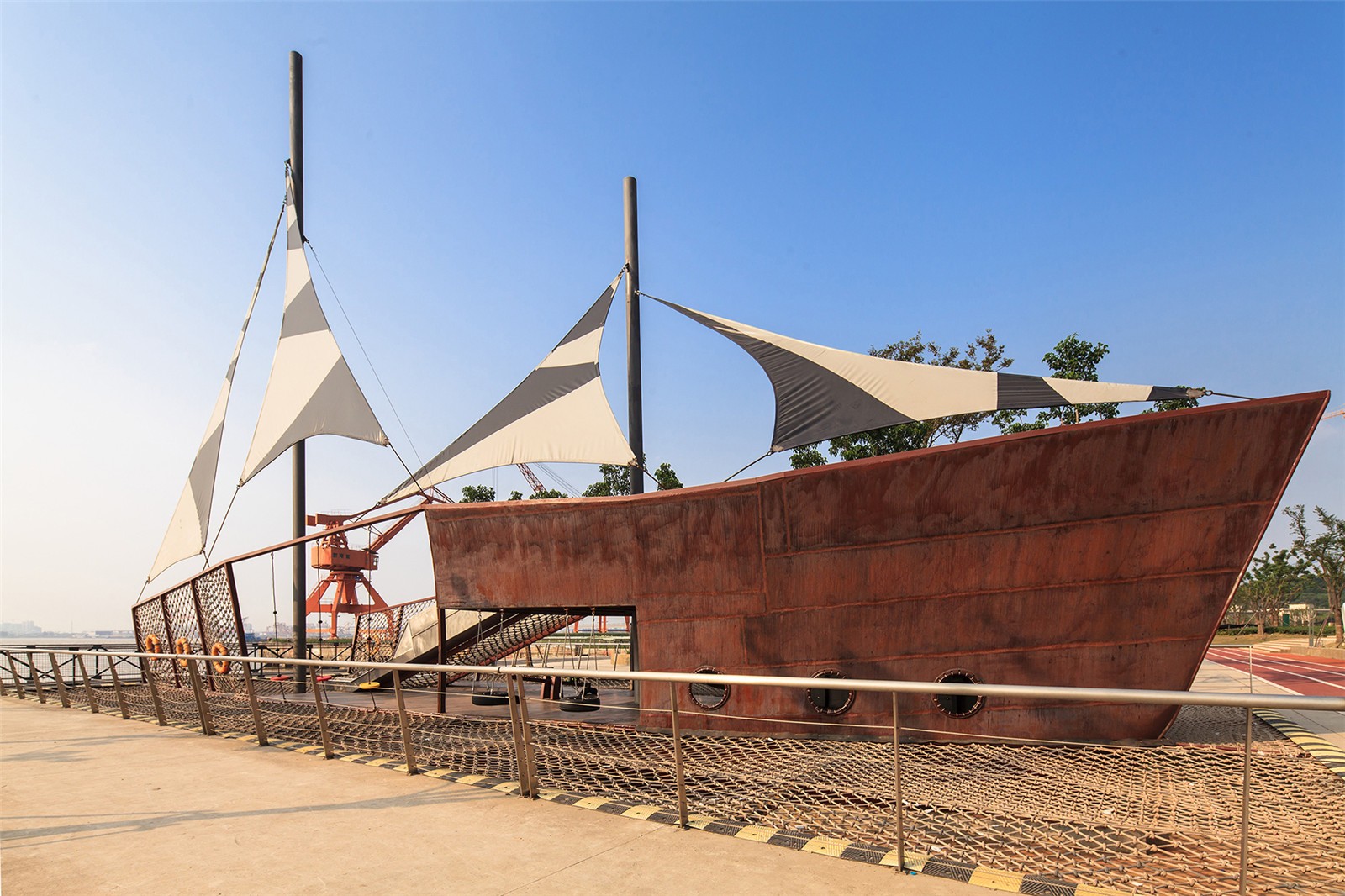
▲船型的兒童探險(xiǎn)游樂場 Children's adventure playground in the form of a ship ? 曾江河
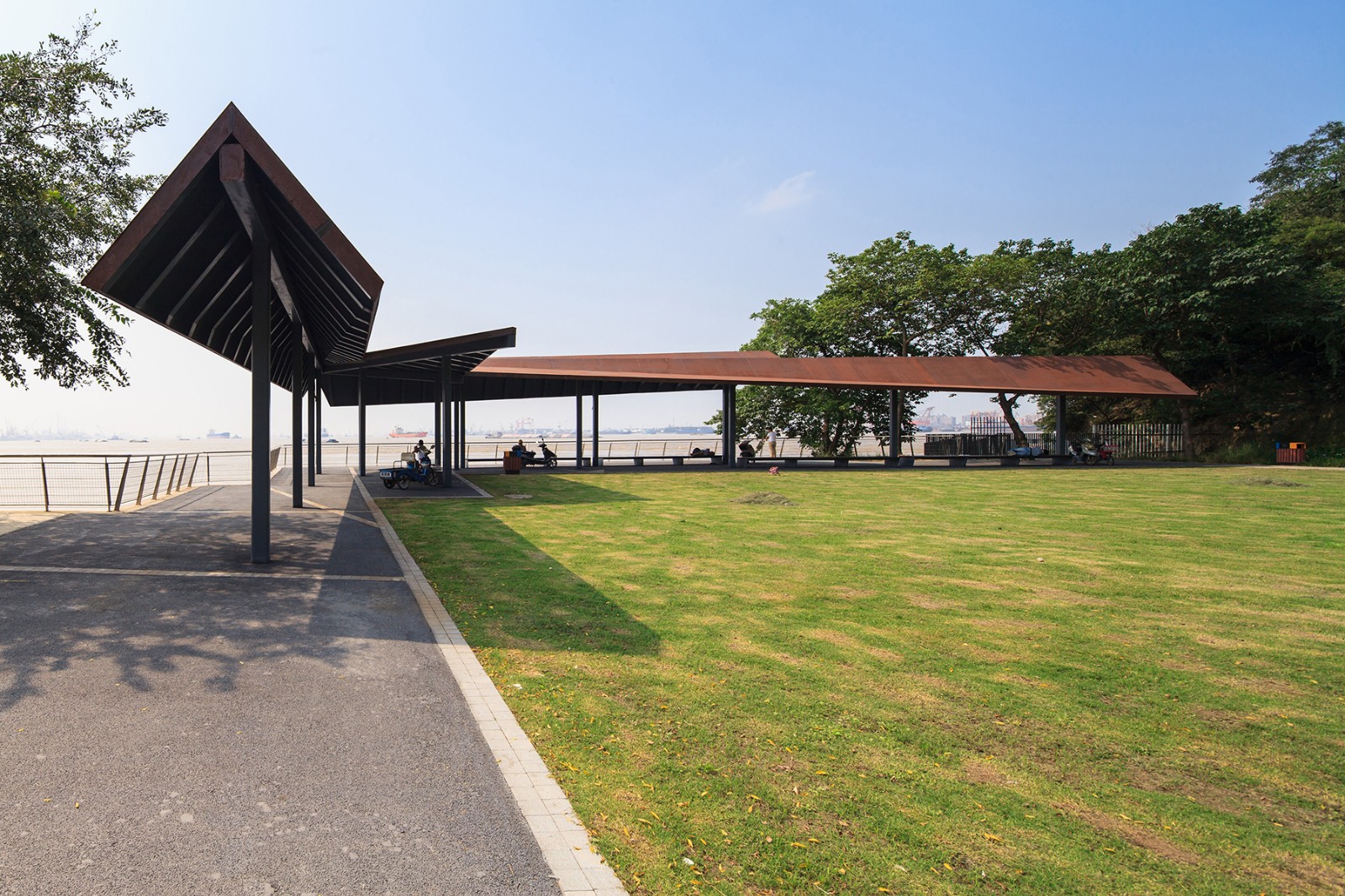
▲小亭子與座椅 Small pavilions and intimate seating ? 曾江河
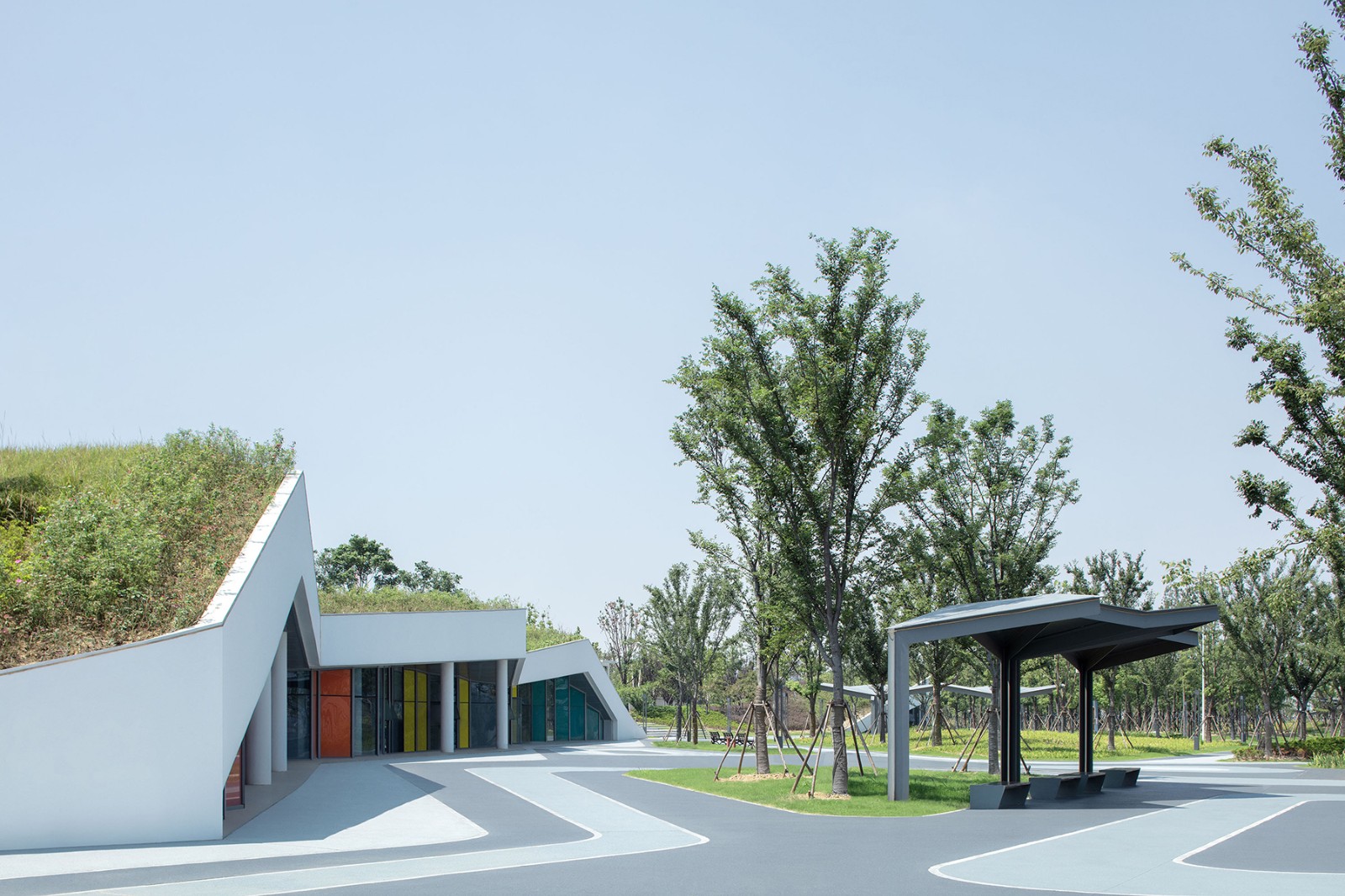
▲小亭子與座椅 Small pavilions and intimate seating ? 夏至
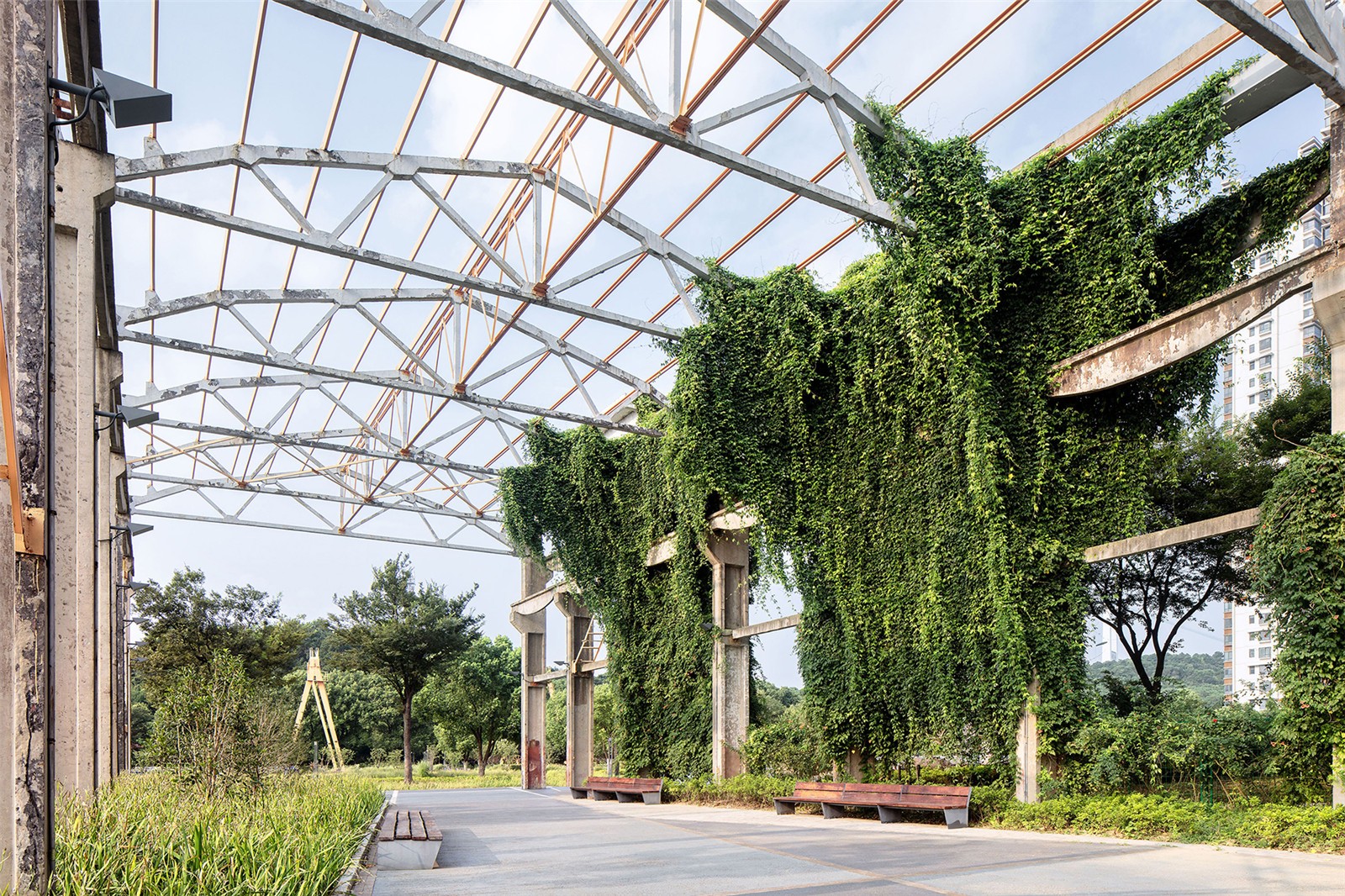
▲場地保留了工業(yè)特色和粗獷的結(jié)構(gòu) Industrial character and the most brutal of structures are preserved ? 夏至
三個(gè)歷史港口
Three Historic Ports
江陰的港口歷史可追溯至唐代(公元618-907年)。研究揭露了當(dāng)?shù)厝齻€(gè)歷史港口的位置:黃田港�,據(jù)說其形成于近2000年前,如今被開發(fā)成港區(qū)的主要公共活動(dòng)空間���,地面鋪裝上則加入了對(duì)長江的解說地圖�����。韭菜港的最新版本是修復(fù)后的工業(yè)港���,一個(gè)被設(shè)計(jì)成起伏山丘的餐廳為居民提供了遠(yuǎn)眺臺(tái)。鰣魚港�����,曾是當(dāng)?shù)刂~市���,歷史可追溯至16世紀(jì)��,通過新的景觀設(shè)計(jì)��,這里建立了廣場���、公園和鮮魚餐廳�,并提供與鰣魚港相關(guān)的信息和解說��。
Jiangyin’s origins as a port city date back to the Tang Dynasty (618-907 AD). Research revealed the location of three historic ports. The site of Huang Tian Port, reputedly dating back nearly 2000 years, has been developed as the dockland’s major open space for public events. Interpretive mapping of the Yangtze River is integrated in its paving. Historic Jiu Cai Port has been named and restored in its most recent iteration, as industrial port. A new restaurant designed as an urban hill provides a lookout point. Shiyu Port dates from the 1500s and was a renowned fish market. The new landscape here establishes a plaza, park, and fish restaurant. An integrated paving artwork provides further interpretation.
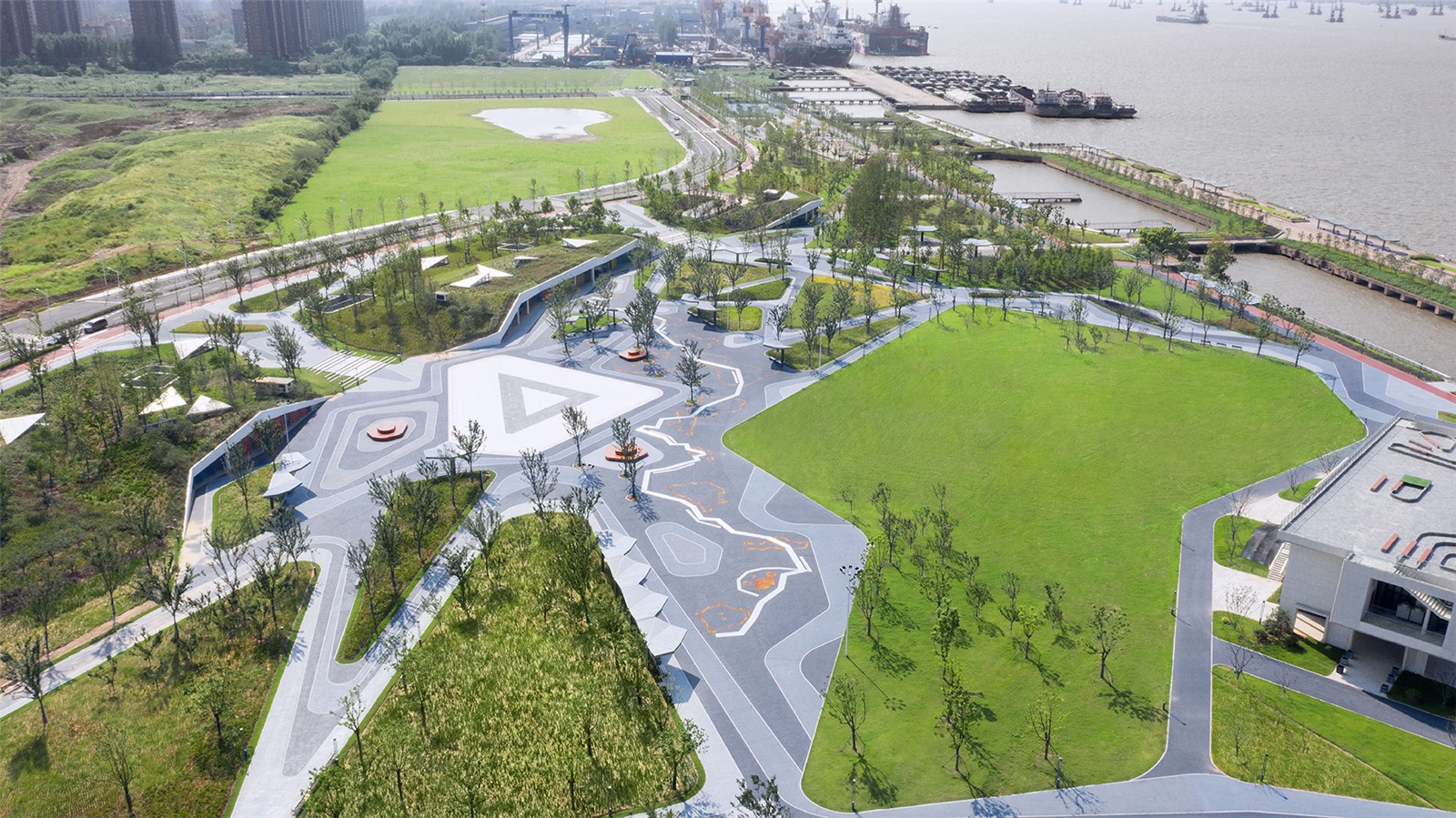
▲2000多年歷史的黃田港成為港區(qū)的主要公共活動(dòng)空間 The site of Huang Tian Port, reputedly dating back nearly 2000 years, has been developed as the dockland's major open space for public events ? 夏至
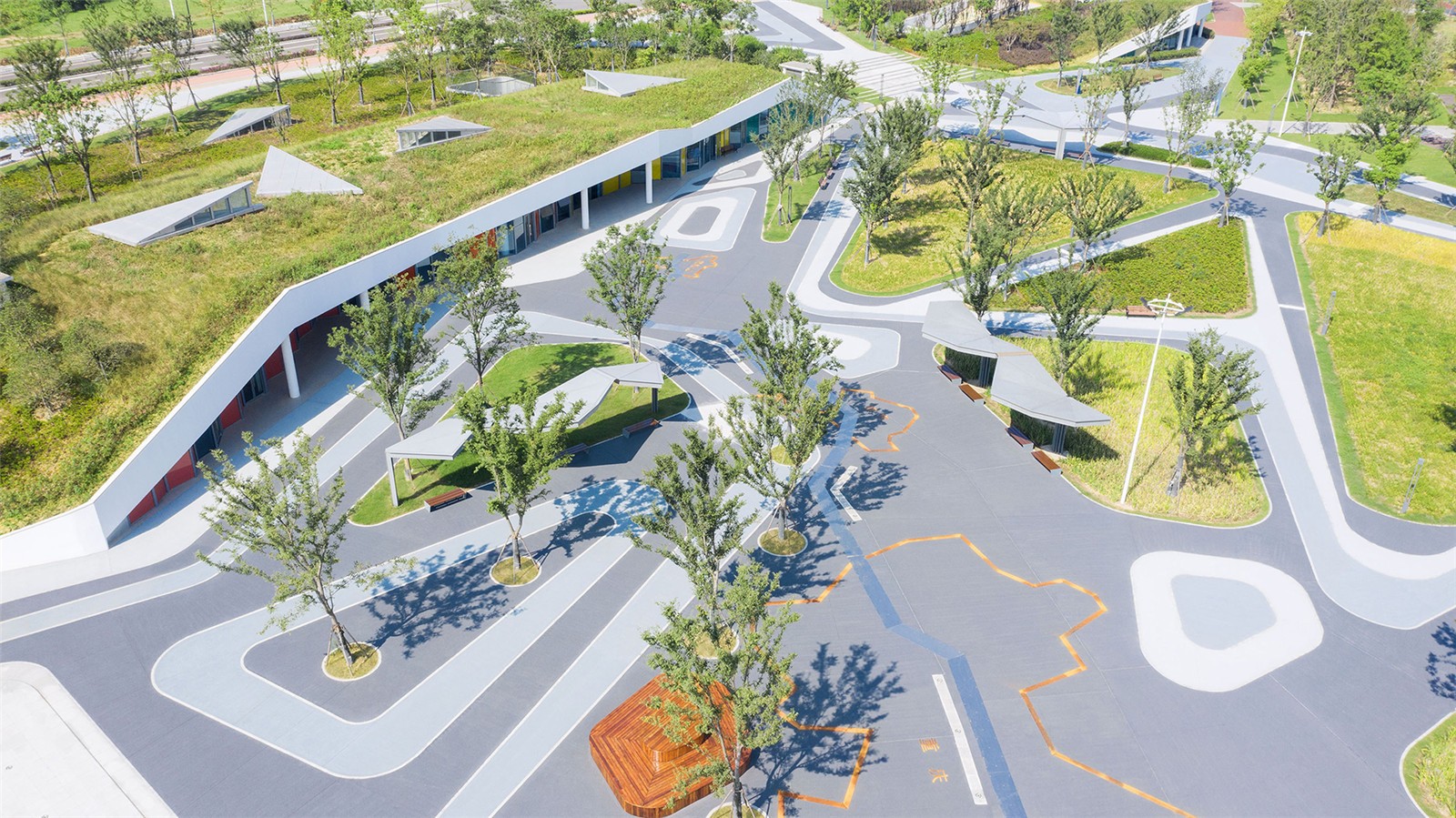
▲地面鋪裝上的長江解說地圖保留了場地歷史 Interpretive mapping of the Yangtse River is integrated in its paving. Maintaining presence of the historic past ? 夏至
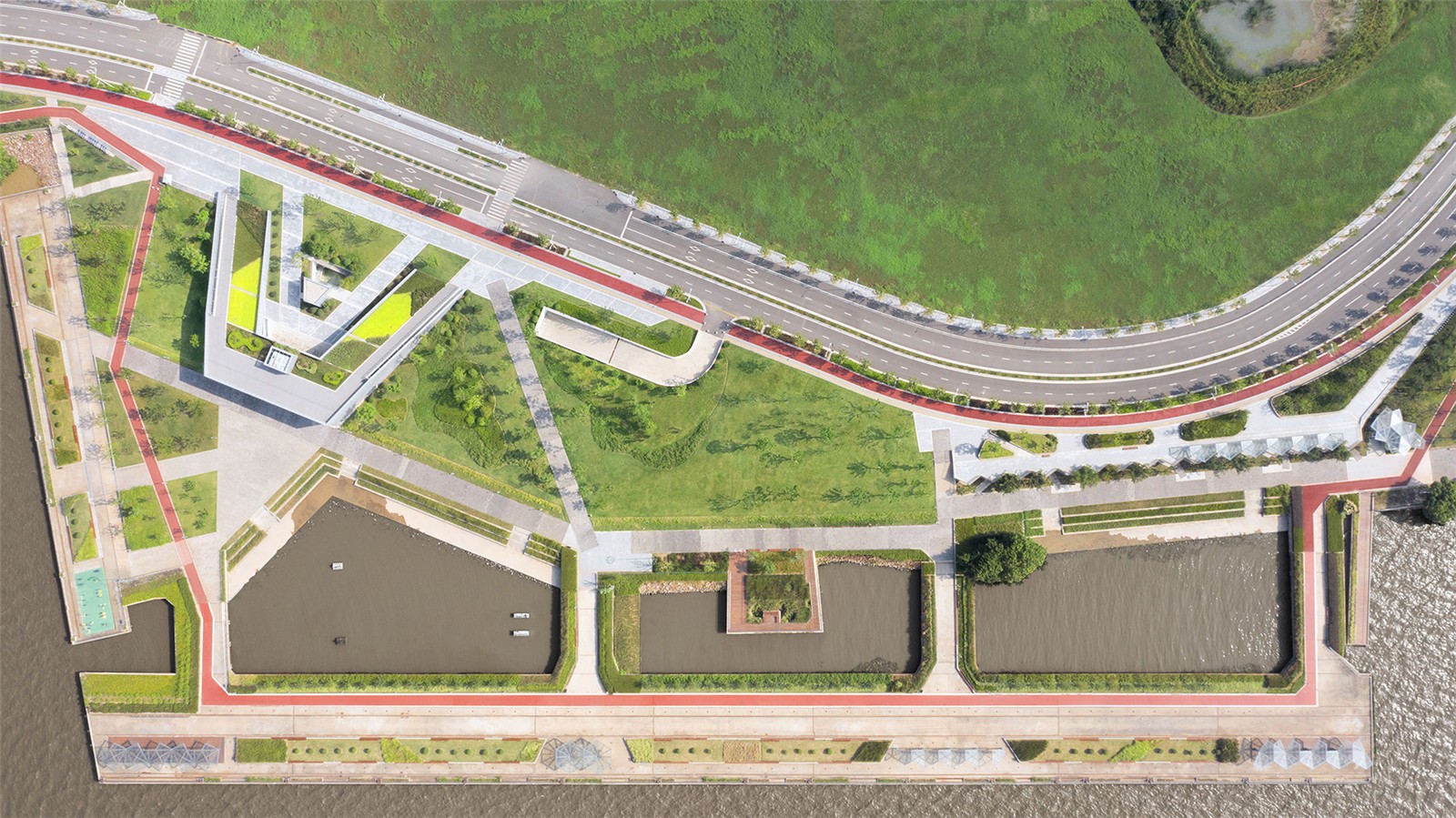
▲韭菜港作為工業(yè)港口進(jìn)行修復(fù) Jiu Cai Port has been named and restored in its most recent iteration, as industrial port ? 夏至
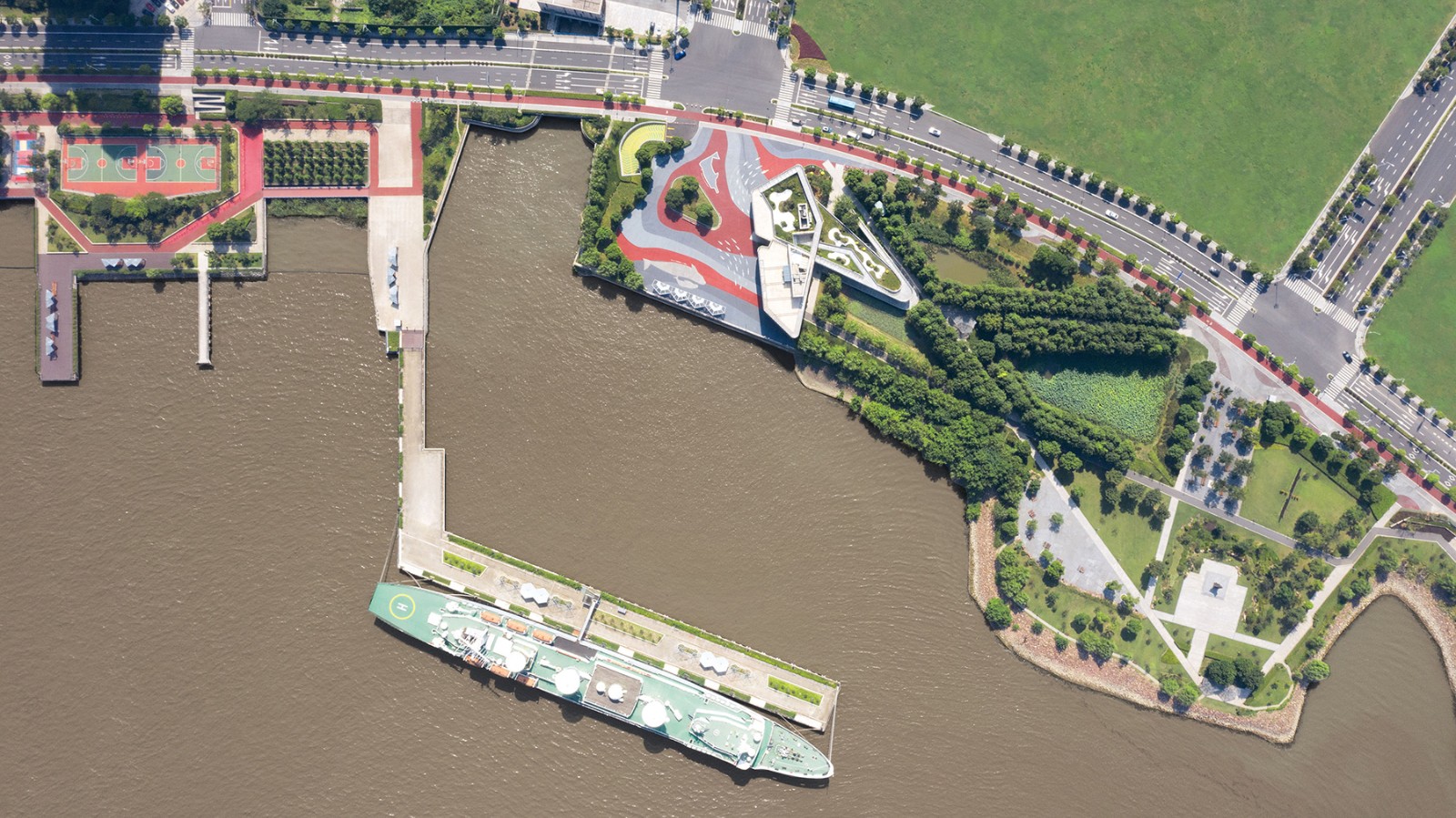
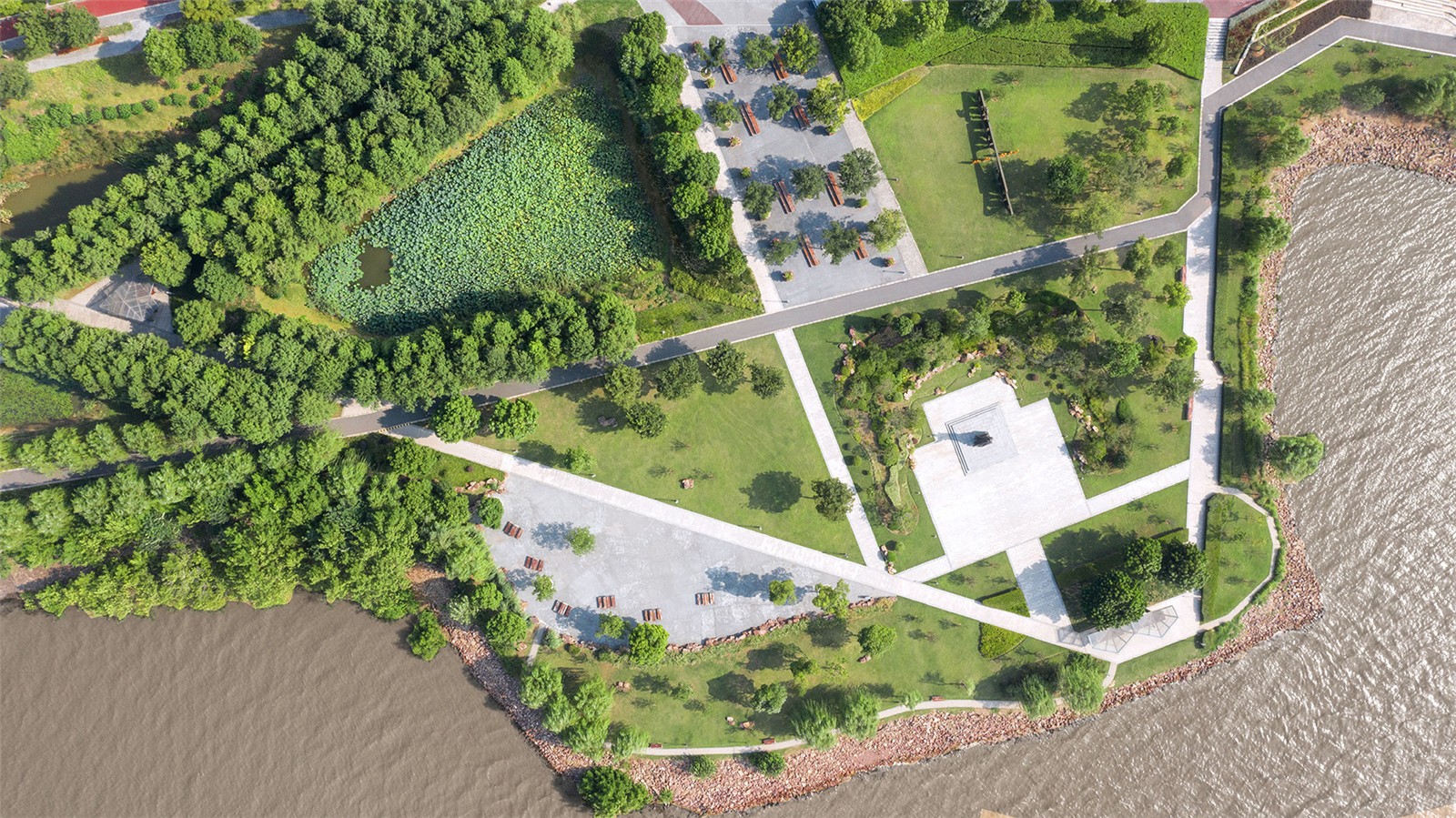
▲原為魚市的鰣魚港改造后成為擁有鮮魚餐廳的公園廣場 Shiyu Port was a renowned fish market and the new landscape here establishes a plaza, park, and fish restaurant ? 夏至
4.休閑新時(shí)代
New era of leisure
自改革開放起�,中國邁入高速發(fā)展期已近50年,中國國民也不斷探索多樣的休閑娛樂活動(dòng)�。從稚嫩兒童到年邁長輩,濱江公園的景觀設(shè)計(jì)為各個(gè)年齡段的人都提供了適宜的娛樂場所���,這也使其成為江陰最大的樂園����。公園內(nèi)��,一條4公里長的慢跑跑道連接了數(shù)十個(gè)戶外運(yùn)動(dòng)場和健身器材場所�����;另一條更為隨性的小徑貫穿其間�,將數(shù)個(gè)大型兒童游樂場��、一個(gè)滑板公園和大量老年運(yùn)動(dòng)設(shè)備聯(lián)結(jié)?��?紤]到廣場舞的廣泛流行�,我們還在公園內(nèi)設(shè)置了多個(gè)舞蹈廣場�����。此外���,大量涼亭��、游戲桌���、野餐草坪、帳篷都在這里有所歸屬���,未來還將有其他多樣的活動(dòng)空間��。這將使當(dāng)?shù)鼐用襁M(jìn)入一個(gè)新奇有趣的健康娛樂時(shí)代��。
After a hiatus of nearly fifty years China is prospering and its citizens are rediscovering all variety of leisure pursuits. This landscape introduces opportunities for the very young to the very old. It is the city’s largest playground. Linked by a 4km jogging track are dozens of outdoor sports courts and frequent gym equipment stations for public use. A more leisurely path weaves the length of the site and connects several large children’s playgrounds, a skate park, and numerous groupings of exercise equipment for the elderly. Frequent throughout the landscape are dancing plazas, a popular local pursuit. A host of pavilions, tables for games, and lawns for picnics, tents and programs yet to come. The park ushers in a novel, exotic era of health and play.
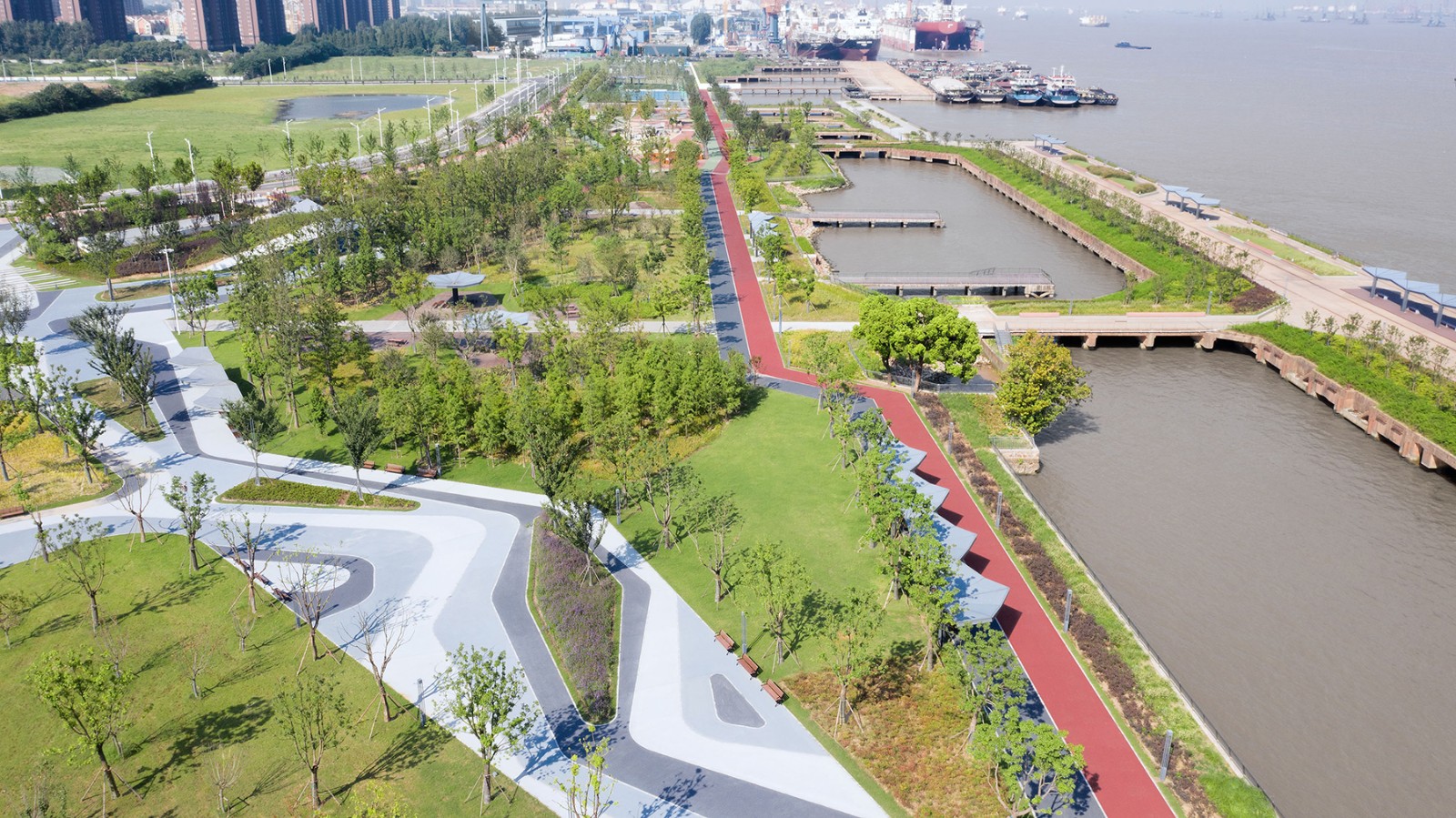
▲4公里長的慢跑道 A 4km jogging track ? 夏至
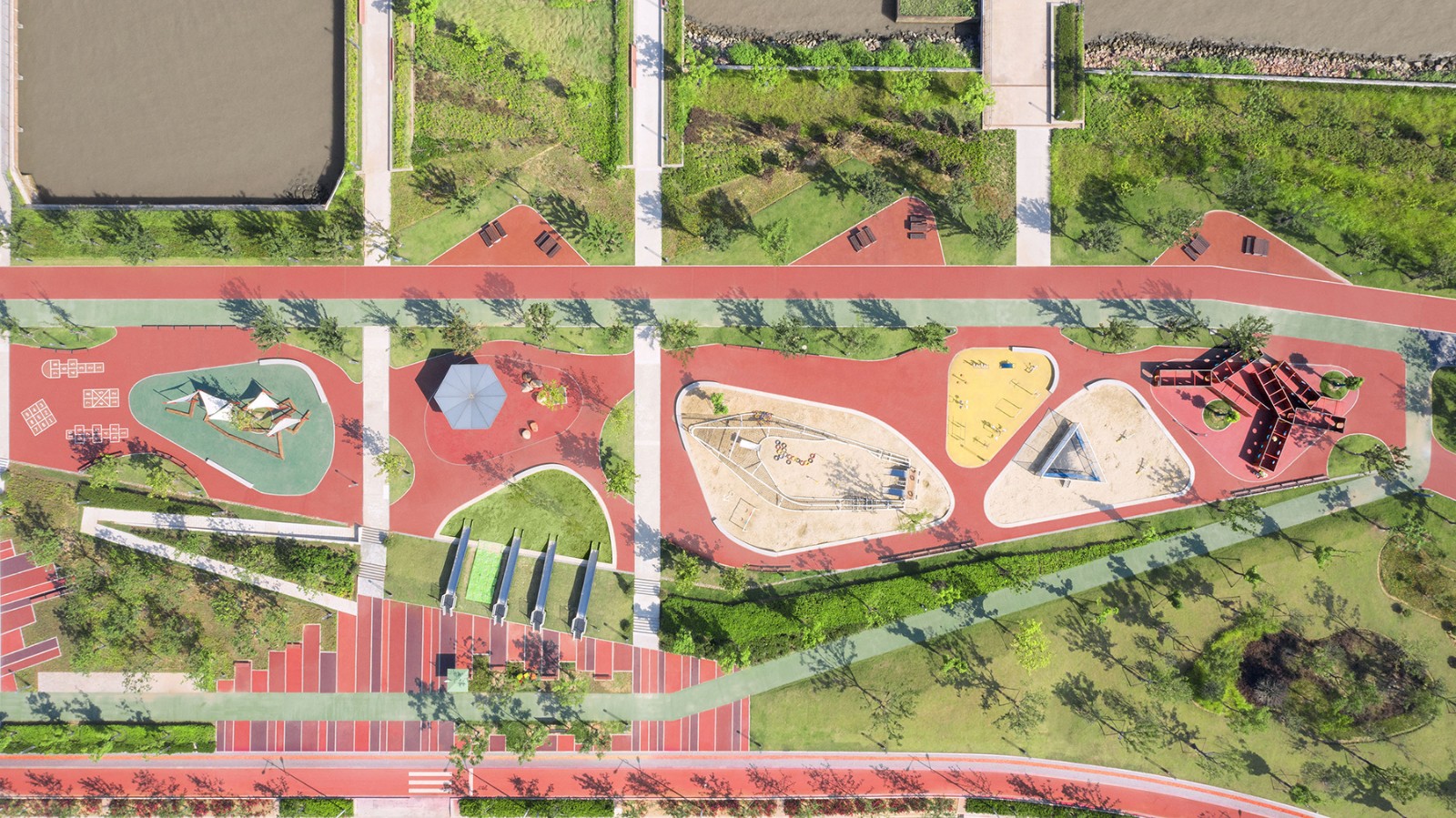
▲豐富的休閑設(shè)施 variety of leisure pursuits ? 夏至
5.新興的公園網(wǎng)絡(luò)
Emerging park network
濱江公園內(nèi)的自行車道是一條20km自行車環(huán)路的起點(diǎn)����,這條環(huán)路貫穿江陰市,沿途連接了市內(nèi)已建成或處于規(guī)劃中的線性公園�。公園間的這種連接也是一種生態(tài)上的聯(lián)結(jié),一片廣闊的生態(tài)系統(tǒng)網(wǎng)絡(luò)正在涌現(xiàn)���。人行步道沿著長江水岸延展����,東面設(shè)置的棧道帶領(lǐng)人們通往陡峭的山崖�����。
濱江公園的設(shè)計(jì)同時(shí)也是碼頭區(qū)域與城市建設(shè)區(qū)的連接���。濱江環(huán)流與城市環(huán)流結(jié)合���,景觀路徑自街道軸線向外延伸,各式各樣的廣場與城市-河流景觀長廊正沿這條軸線分布���,在江陰市內(nèi)構(gòu)建了一片新興的公園網(wǎng)絡(luò)。
The bicycle path in this docklands park has initiated a 20km bicycle loop tracing existing and proposed lineal parks in the city. Linking the disparate parks with this loop, or greenway, brings about an accompanying ecological link. An extensive eco-system network is emerging. Pedestrian paths extend along the Yangtze either way. To the east a narrow boardwalk has been installed to enable people to pass around the steep mountain edge. The docklands park is also designed to smoothly connect to the urban district under construction. The circulation of the foreshore is coupled with the urban circulation. Plazas and city-river view corridors are located on street axis from where landscape paths radiate.
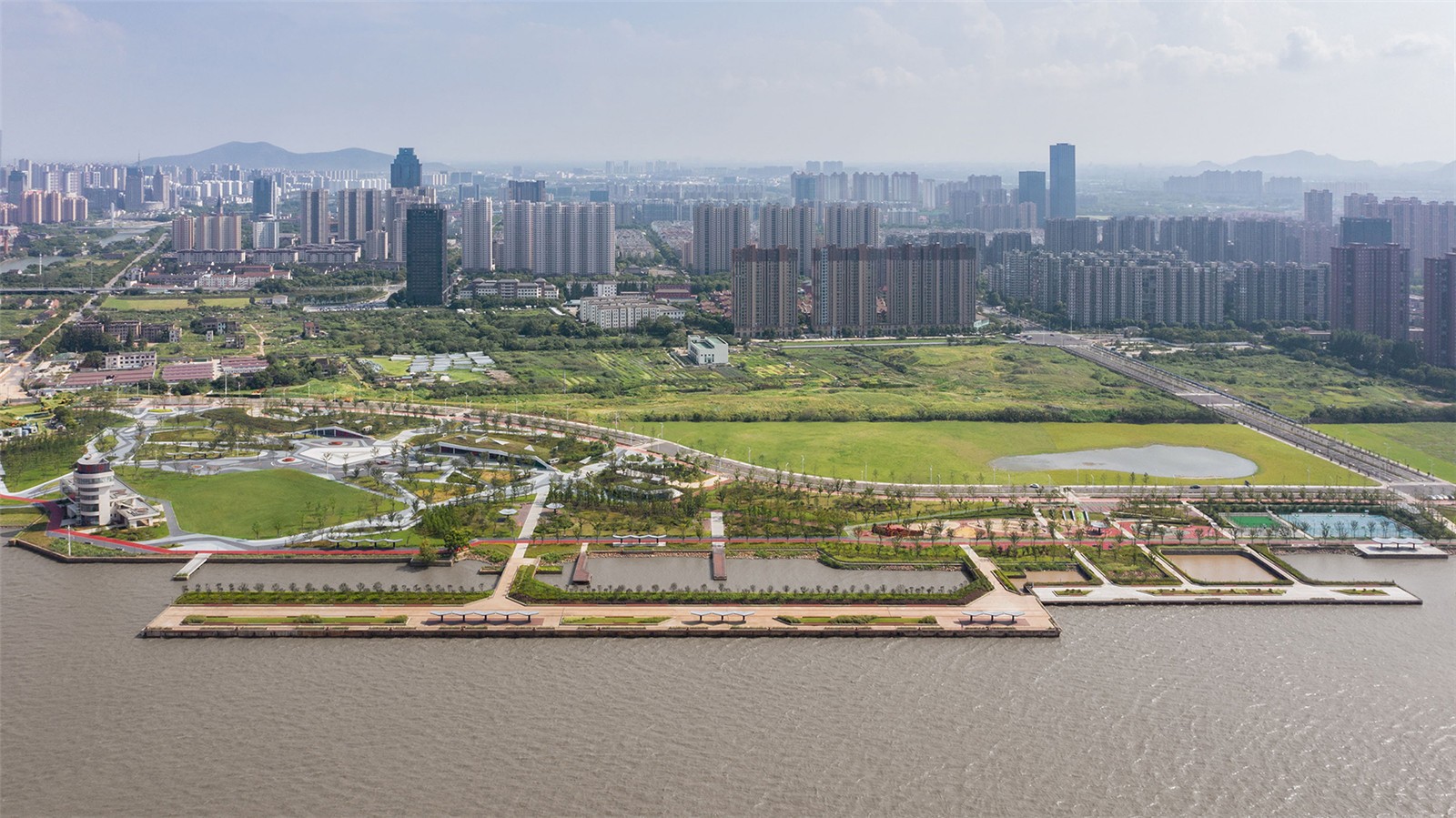
▲連接向場地外延伸��,形成新的城市公園網(wǎng)絡(luò) links beyond the site for the emergence of a city park network ? 夏至
項(xiàng)目圖紙
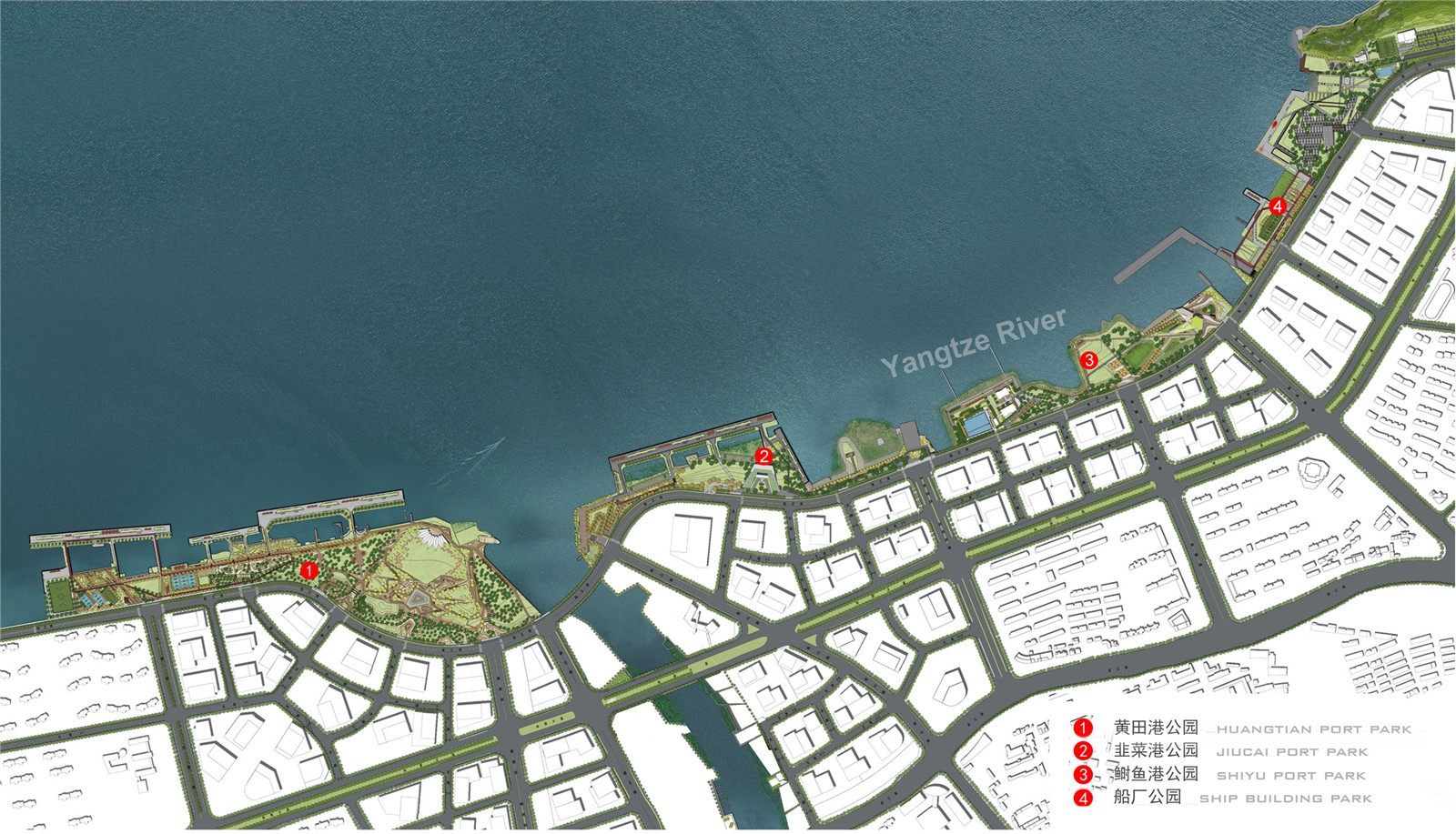
▲總平面圖 Overall masterplan ? BAU

▲船廠公園和鰣魚港公園平面圖 Masterplan ship building park + shiyu port park ? BAU
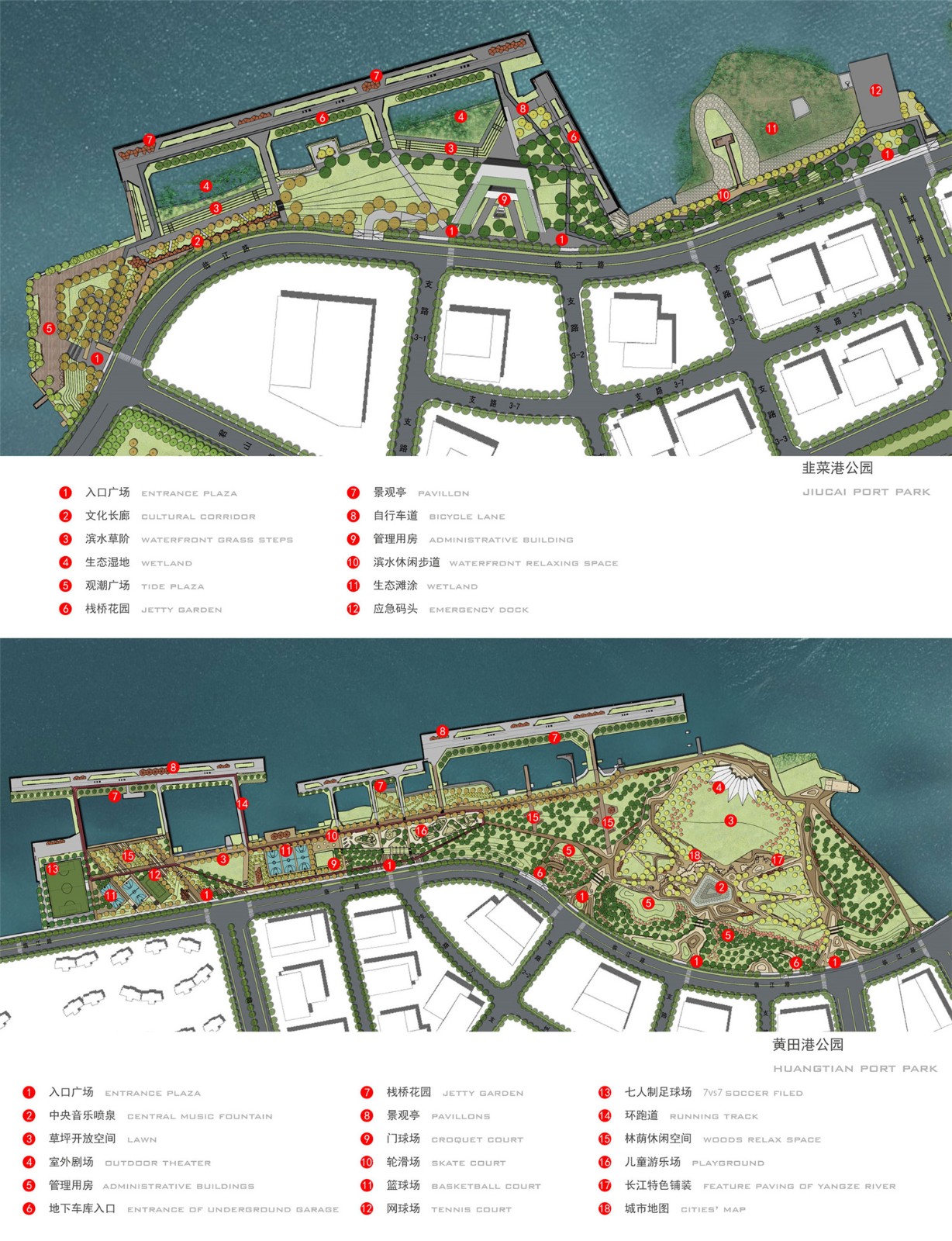
▲韭菜港公園及黃田港公園平面圖 masterplans jiucai port park + huangtian port park ? BAU
Project Status: Completed 2020
項(xiàng)目情況:2020年竣工
Location: Jiangyin City, Jiangsu Province, China
地點(diǎn): 中國����,江蘇省�,江陰市
Year: 2012-2020
年份: 2012-2020
Client: Jiangyin Urban Planning Bureau
客戶: 江陰市規(guī)劃局
Construction Area: 36.7 Ha (Ship Building Park 7.6Ha; Shiyu Port Park 6.9 Ha; Jiucai Port Park 7.2 Ha; Huangtian Port Park 15 Ha)
建設(shè)面積: 36.7公頃(船廠公園:7.6公頃��、鰣魚港:6.9公頃���、韭菜港:7.2公頃��、黃田港:15公頃)
Construction Cost: RMB 369 million (Ship Building Park RMB 30 million; Shiyu Port Park RMB 59 million; Jiucai Port Park RMB 70 million; Huangtian Port Park RMB 210 million)
建設(shè)投資: 3億6千9百萬人民幣(船廠公園:3000萬����、鰣魚港:5900萬��、韭菜港:7000萬���、黃田港:21000萬)
Typology: Public park, sports park, waterfront
類型: 公共綠地�,體育公園���,濱水公園
Program: Sustainable urban drainage, city garden, wetland, parkland, heritage preservation, plazas, emergency docks, skate park adventure playground, tennis courts, basketball courts, gate ball courts, table tennis courts, soccer fields, outdoor swimming pool, outdoor theater, bike paths, running track, pavilions, commercial and amenities buildings and tourist information centers.
功能項(xiàng)目: 可持續(xù)城市排水系統(tǒng)����、城市花園、生態(tài)濕地���、公共綠地�、工業(yè)遺跡保護(hù)�����、廣場��、應(yīng)急碼頭��、兒童游樂場����、極限運(yùn)動(dòng)場、網(wǎng)球場��、籃球場��、門球場�����、乒乓球場�����、足球場�����、室外游泳池����、室外劇場、慢跑道���、自行車道��、景觀亭�����、音樂噴泉�����、商業(yè)及服務(wù)配套建筑�,以及游客中心���。
BAU項(xiàng)目組成員:
BAU Project Team:
方案主創(chuàng):James Brearley
Principal: James Brearley
景觀設(shè)計(jì) Landscape
項(xiàng)目組長:黃芳 Project Leader: Fang Huang
項(xiàng)目組成員:Robin Armstrong����、王粲、熊娟����、李淑蕓、盧穎宏����、方旭杰、陳燕玲�、王晨磊、黃俊彪�、劉小博、Lisa Ann Gray�����、Alexander Abke����、王天葵、羅莉�����、程業(yè)典
Landscape Architecture Team: Robin Armstrong, Wang Can, Xiong Juan, Li Shuyun, Lu Yinghong, Fang Xujie, Chen Yanling, Wang Chenlei, Huang Junbiao, Liu Xiaobo, Lisa Ann Gray, Alexander Abke, Wang Tiankui, Luo Li, Cheng Yedian
建筑設(shè)計(jì) Architecture
項(xiàng)目負(fù)責(zé)人:蔣涵 Project Manager: Jiang Han
項(xiàng)目組成員:Steve Whitford �、Joseph Tran、張旭����、高衛(wèi)國、倪瑋���、侯慧麟����、Tatjana Djordjevic�、李福明、王克明�、李冬冬、楊泰����、莆棱烽、郭林
Architecture Team: Steve Whitford, Joseph Tran, Zhang Xu, Gao Weiguo, Ni Wei, Hou Huilin, Tatjana Djordjevic, Li Fuming, Wang Keming, Li Dongdong, Yang Tai, Pu Lengfeng
施工單位: 江蘇大自然環(huán)境建設(shè)集團(tuán)有限公司���、常熟古建園林股份有限公司�����、蘇州吳林園林發(fā)展有限公司
Contractor: Jiangsu Natural Environment Construction Group Co., Ltd., Changshu Traditional Chinese Architecture & Landscaping Construction Co.,Ltd., Suzhou Wu Lin Landscape Development Co., Ltd.
配合設(shè)計(jì)院:江陰市城鄉(xiāng)規(guī)劃設(shè)計(jì)院
Engineer: Jiangyin Urban and Rural Planning Design Institute
景觀施工圖: 江陰市城鄉(xiāng)規(guī)劃設(shè)計(jì)院
Landscape Construction Documentation: Jiangyin Urban and Rural Planning Design Institute
3D渲染: BAU
3D Rendering: BAU
攝影: 曾江河�����、夏至
Photographs: Zeng Jianghe, Xiazhi
 京公海網(wǎng)安備 110108000058號(hào)
京公海網(wǎng)安備 110108000058號(hào)



























